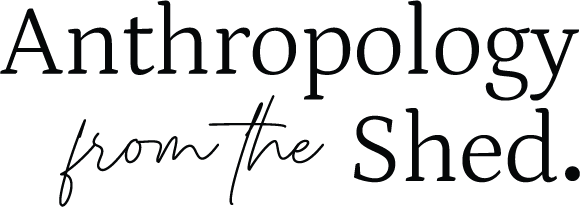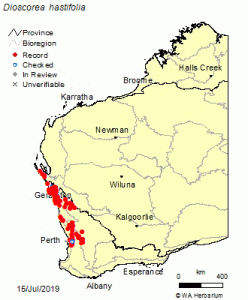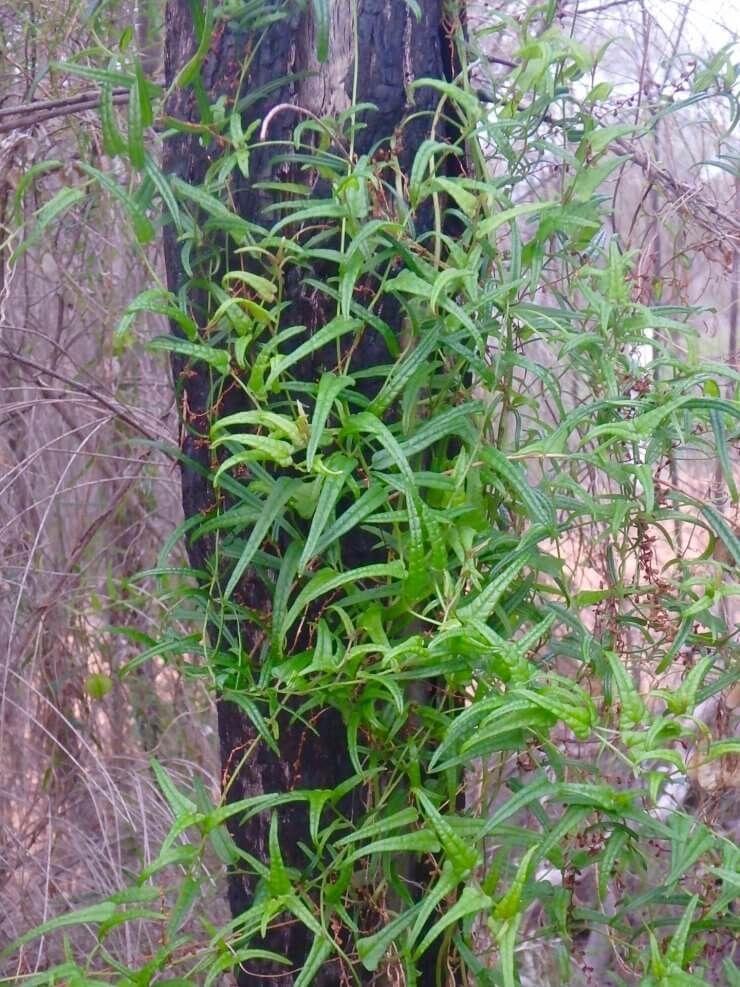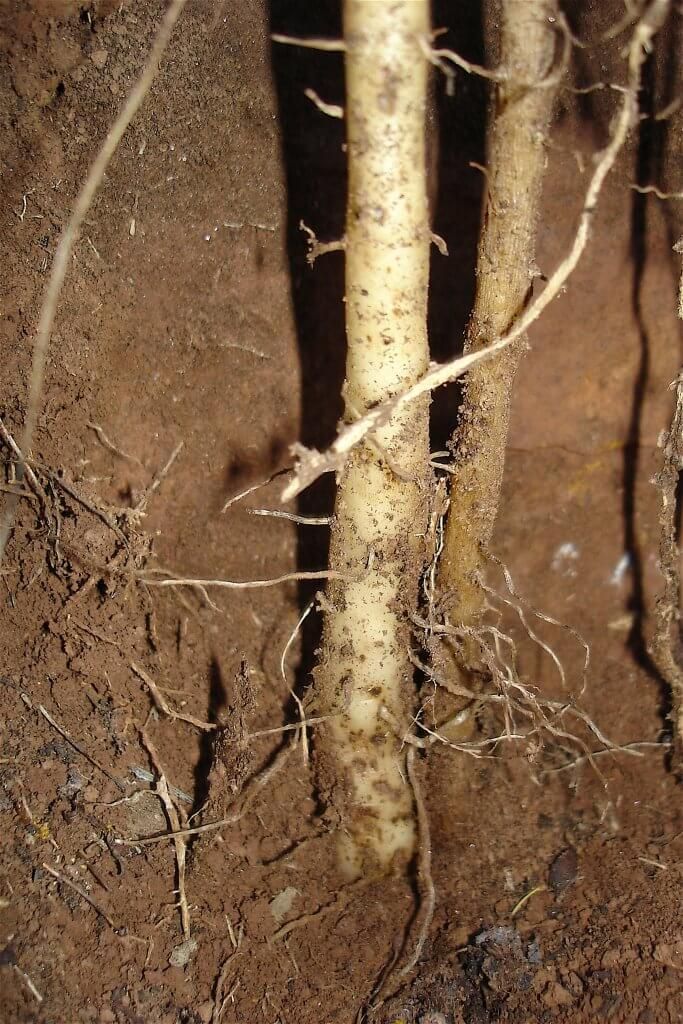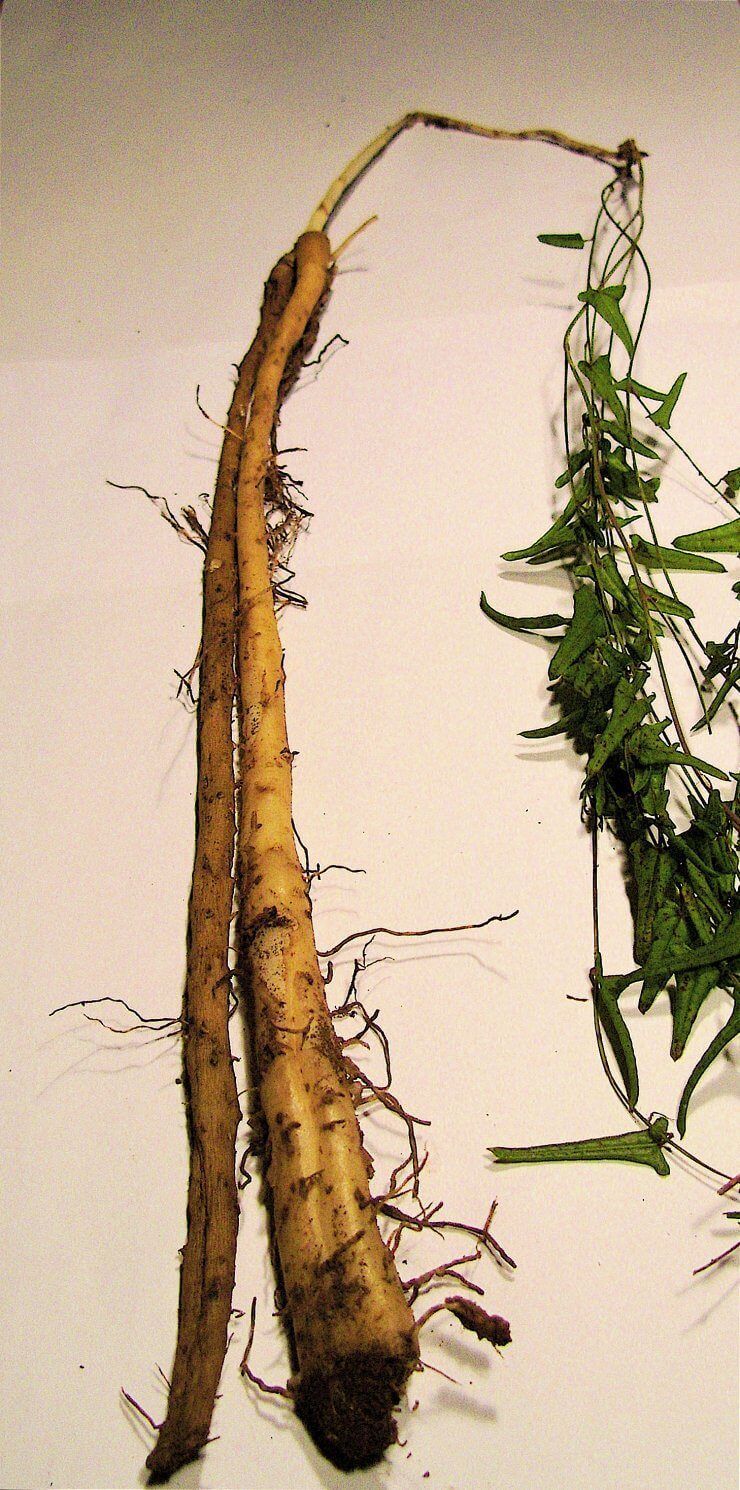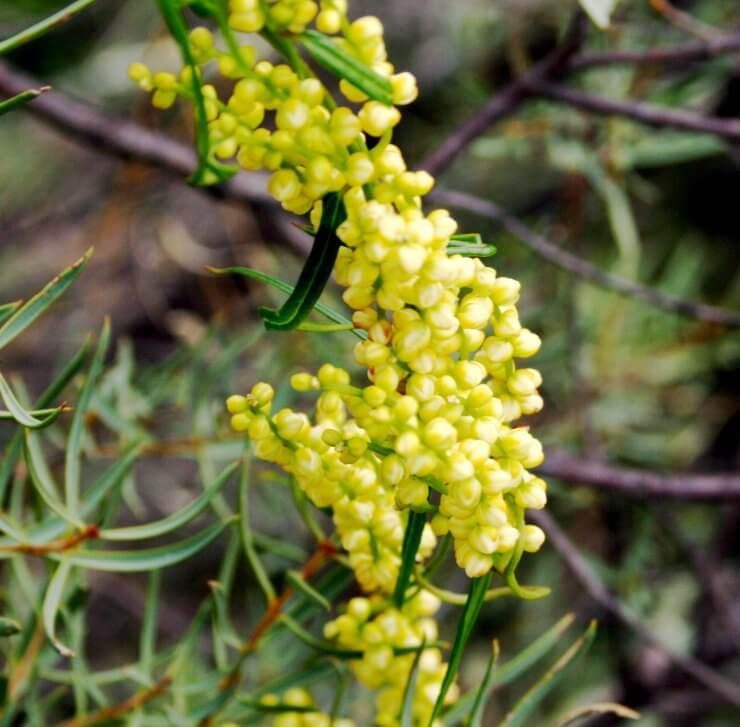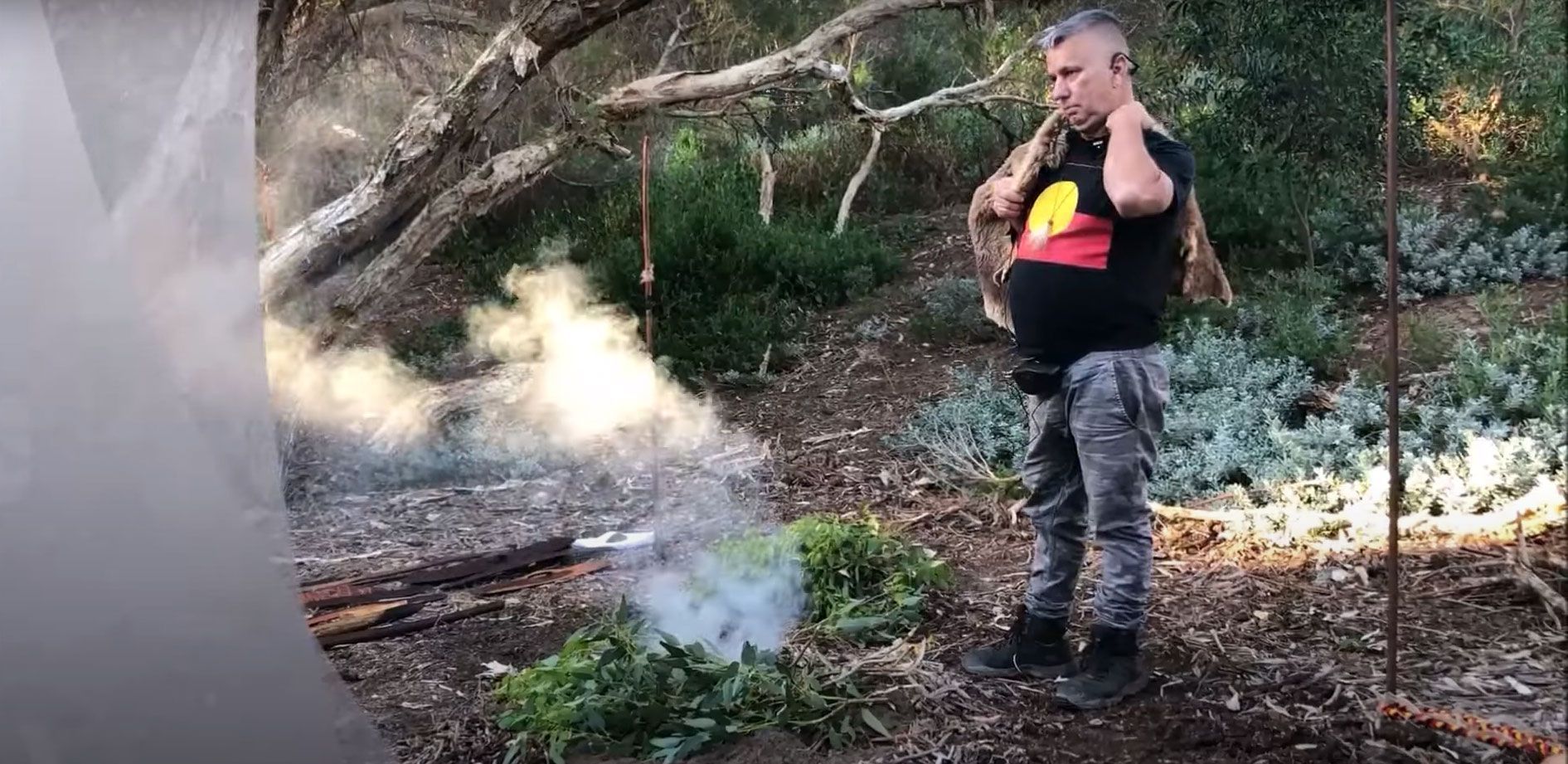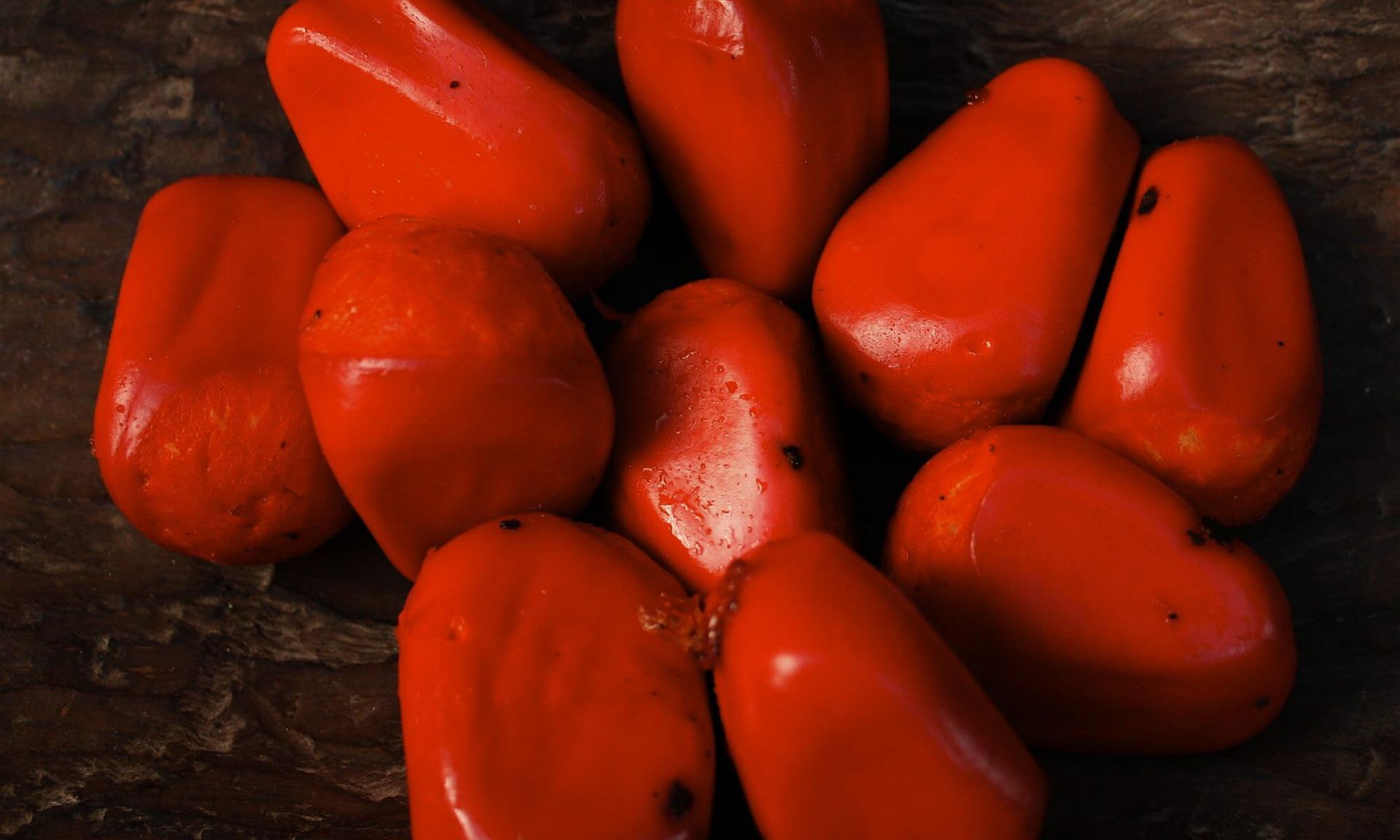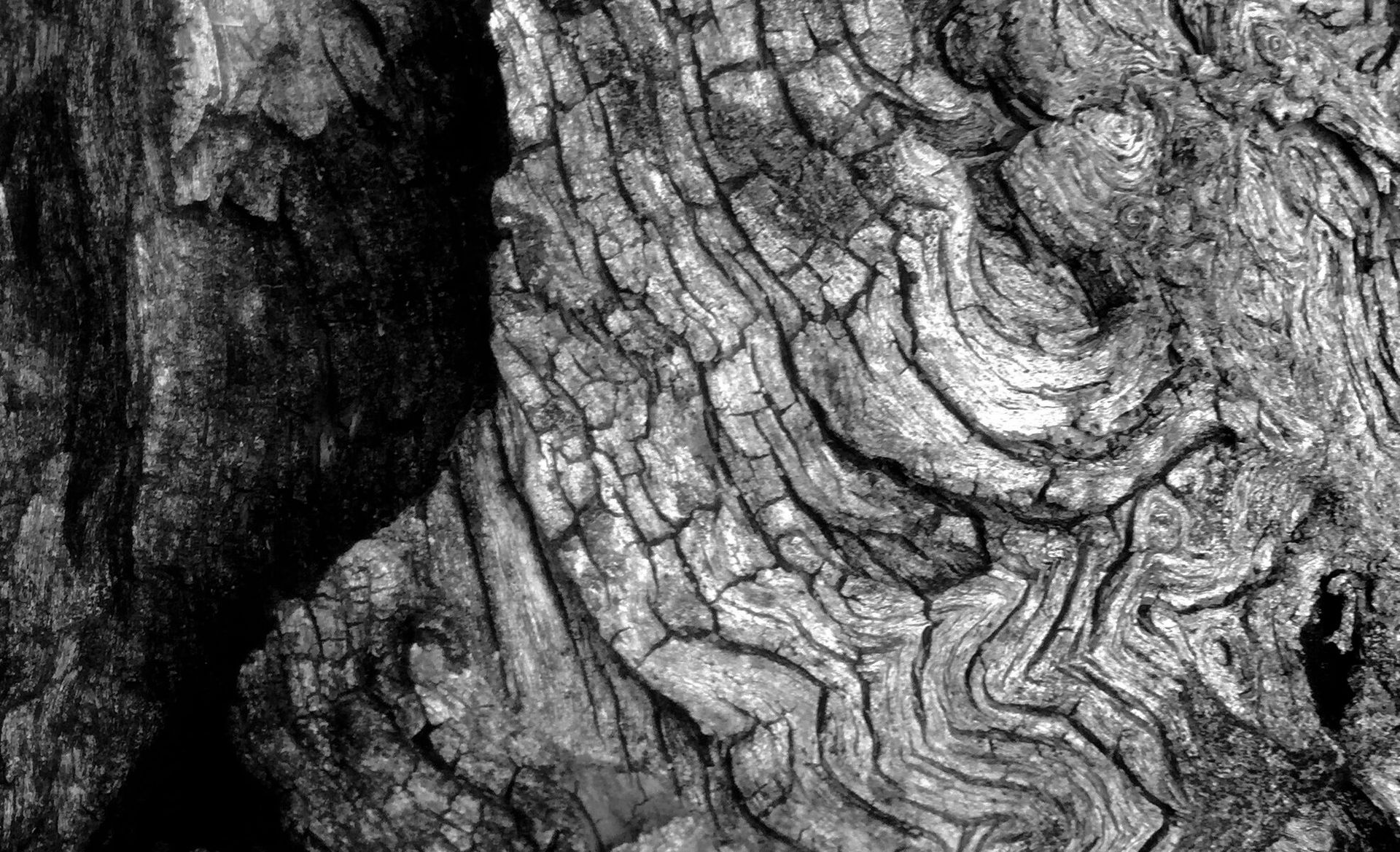Yam Lands: the Mystery of a Holey Landscape
Yam Lands: the Mystery of a Holey Landscape
By Ken Macintyre and Dr Barb Dobson, Research anthropologists and Iva Hayward-Jackson, Nyungah Land and Culture Protector, Heritage consultant and Researcher.
Dioscorea hastifolia, the native yam, was once an important cultivated food staple of the Aboriginal people of northern southwest Australia. In this paper we attempt to show how European colonial settlement and agriculture consciously destroyed this once dependable indigenous horticultural resource. As we point out throughout our research it was not a secret to the early European explorers and settlers that Aboriginal people had been – and still were – actively performing horticultural activities up until the time that their land was expropriated by the colonial government. Aboriginal people in northern southwest Australia had evolved over many thousands of years their own method of pit horticulture to cultivate yams. It is highly probable that the D. hastifolia yam known as warrain or warrein was transplanted at some point in prehistory from its natural upland rocky habitat to the more accessible, fertile, alluvial lowland slopes and river terraces. This, together with a water-conserving pit method of dry land horticulture, would have been a more economically productive system with an improved predictability of this valued food resource. Similar types of pit horticulture are found in other cultures with semi-arid climatic conditions, such as in northwest Africa where it is known as “zai” or “tassa.” It is a proven means of harvesting unreliable rainfall, improving soil structure, preventing erosion, increasing crop productivity and mitigating against an increasingly drying climate.
Part 1: The Nyungar yam-flood origin narrative
‘Some of the Mountain Natives give a curious tradition of their first knowledge of the native Yam….. They say, the Earth was at one time covered with water, when one black man and woman found themselves on a rock on the top of a very high Mountain. They were reduced to the extremity of hunger, but the water retiring, left the roots of the Wyrang exposed. They had nothing to do, but gather them and eat. In process of time it spread over the Country and got deeply embedded in the Earth, and now they require much labour to dig them. Such is an ancient tradition, handed down from generation to generation. The man and woman were the parents of all the tribes in the interior of this extensive Island, and their descendants consider themselves the oldest inhabitants of the country.” (Drummond 1837 Swan River Guardian).
This is the earliest documented narrative of the Dioscorea hastifolia yam explaining its origin and significance in Nyungar culture from the time of the Ancestral Dreaming. Like other origin myths, it represents only a fragment of a larger cultural narrative that once would have encoded, possibly in song and ceremonial performance, instructional knowledge of the yam’s cultivation, propagation, preparation and associated rituals. Indigenous scientific and cultural information was passed down orally over many thousands of years. James Drummond, the colonial botanist, collected the above narrative from the “mountain people” of the York area (probably Ballardong informants). His account was originally published in the Swan River Guardian in 1837 and later re-published by William Nairn Clark in the Inquirer in 1842. The story expresses the origin and importance of the yam as a foundational food source given to the Nyungar people by their ancestors.
Clark (1842) and Backhouse (1843) further emphasise the yam’s deep connection to water as revealed by the flood narrative. Backhouse, who was invited to George Fletcher Moore’s property at MIllendon (in the Upper Swan area), writes:
‘We examined some holes, where the Natives had been digging for roots of a Dioscorea, or Yam, for food. This plant climbs among bushes, in a strongish soil, and the Natives have a tradition, respecting its roots having been conferred upon them, in which there are traces of the deluge.’ (Backhouse 1843: 540).
‘Those [Aborigines] of the Swan River are thought to have traces of a tradition respecting the Flood, in connexion with the possession of a Yam, having an esculent root, as noticed at page 540.’ (Backhouse 1843: 557).
We can only imagine that this fragment of the Nyungar Yam-flood origin narrative would have been a topic of interest to the predominantly Christian elites of the new colony who were continually looking for Biblical parallels in Aboriginal beliefs.
Dioscorea hastifolia is endemic to Western Australia (Atchison 2000):
‘D. hastifolia and D. transversa are considered to be the only endemic yam species in Australia probably introduced from the D. alata group across the Torres Strait from New Guinea. ‘ (Atchison 2000 citing Yen 1995).
D. transversa (the long yam, parsnip yam, pencil yam) and D. alata (the water yam, purple yam) are both tropical yams unlike D. hastifolia. According to historian Rupert Gerritsen (2014) D. hastifolia was a tropical yam cultivar introduced from Southeast Asia to the Nhanda Aboriginal people of the Murchison, Western Australia by two Dutch mutineers from the ship-wrecked Batavia who after the insurgency in 1629 were purposely marooned on the mainland by Captain Pelsaert for the sole purpose of interacting with the indigenous inhabitants. Gerritsen argues that these two participants (a soldier and a cabin boy) introduced the yam and knowledge of its cultivation to the Nhanda men together with a host of other innovative ideas such as how to construct deep wells and clay-daubed houses for permanent living. We find Gerritsen’s idea of native yam cultivation as a European innovation highly fanciful. It exemplifies colonialist thinking and classic archetypal diffusionist theory that deprives Aboriginal people of the ingenuity and ability to adapt and innovate their own home-grown food staple.
Dioscorea hastifolia yam
The term “yam” is confusing as it often applies to more than one type of root vegetable consumed by the traditional inhabitants of southwestern Australia. (The term “yam” originates from a West African language where nyami or yam means “to eat”). The focus of this paper is the botanical yam Dioscorea hastifolia known by Nyungar people as warrain (e.g. Bimbar in Hope 1916; Bates in Bridge 1992), warrein (Jubaitch in Bates n.d.; Preiss 1839 in Lehmann and Preiss 1844-1848), woyay (Moore 1835), warran (Grey 1840), warran (Moore 1842), wyrang (Drummond 1842), warran (A.C.Gregory, F.T. Gregory and H.C. Gregory 1846) wirang (A.C. Gregory 1887), werrang (Stokes 1846), warran, warren (Roe 1847), warrang (Wollaston 1848, Foley 1851), warang (Burges 1851), uaragn (Salvado 1851 in Stormon 1977), worrain (Roth 1902), warryn (Hammond 1933:28), woorine (Robin Roe in Hallam 1975: 13-14), warrine (Chauncy 1848; Florabase WA 1994; Hansen and Horsfall 2019: 360), wuagarn (Von Brandenstein 1988:131) and warrany (Wheatbelt NRM 2009).1
In the Murchison region this same Dioscorea species of yam is known in the Yamatji language as aj-juco or ad-ju-co (Oldfield 2005:70, 74), also adjuka (Roe 1847 in Hercock 2014:392), a-jack-o (Burges 1851), ajuca (Gregory 1887) or adtjikoh (Hammond 1933:28).
D. hastifolia is a herbaceous perennial with vertical paired “stem tubers” (see Plates 2-4). Local botanists Pate and Dixon (1982: 18) describe these long white roots as follows:
‘stalked and penetrate downwards for up to half a metre before enlarging into a relatively thick, cylindrical structure.’
‘In a typical growing season, a plant comprises a pair of stem tubers. One is a parent tuber, formed from the previous season’s growth, and the other, a replacement tuber, forming and filling with new storage material. The pair occur vertically, often side by side, and originate from modified leaf axils. They emerge from opposite sides of a node located on the lowermost part of the stem’ (Pate and Dixon 1982).
Dioscorea hasitfolia is dioecious, meaning that it has separate male and female flowering plants. The bright yellow flowers of the male plant are conspicuous from May to July. Drummond describes the flower as follows: ‘…the male is a yellow, sweet scented creeper, the female inconspicuous at this season’ (Drummond 4th May 1842, Letter No. 2 to the Inquirer). In its natural environment the plant reproduces from wind-carried winged seeds. This yam can also reproduce vegetatively under cultivation, as demonstrated by the traditional Nyungar cultivators of this plant. See Part 4 of this paper “Indigenous Science and Yam Stick Horticulture,”
The geography of the warrain yam
Yams of the Dioscorea genus are most often found in tropical regions, such as in Northern Australia, Asia, Africa and South America. However, Dioscorea hastifolia, the subject of this paper, grows in semi-arid and Mediterranean type climates, from Shark Bay in the north of Western Australia to the Murray River, south of Perth (see Figure 1). The 19th century botanist Baron von Mueller states that this species is ‘Extra-tropic Western Australia, at least as far south as thirty-two degrees.’ It was once commonly found in the rich loamy soils of upland areas and the river valleys of the Darling escarpment and eastwards to York. This species grows in a wide variety of soils ‘Grey sand, granitic & basaltic soils, laterite’ (Florabase WA 1994). Bates (in White 1985:261) describes its southern geographic limit as follows:
‘It does not appear to go south of the Murray River, because, according to the natives, the Ancestors made that river its southern coastal boundary. It is however found inland amongst the hills of the Darling Range, upon the lower slopes of which it grows plentifully.’
From our observations of the yam (D. hastifolia) growing in its natural upland, stony, loamy soil environment, such as on our property at Toodyay, the plant grows in depressions and crevices between rocks as it searches out moist niches in the environment. It is often found at the base of granite outcrops and rocky hollows where subsurface water collects. This yam grows in well-drained soils and the surface or subsurface rocks often provide a stony mulch that traps moisture and provides a favourable environment for yam growth. In its wild habitat Dioscorea is often associated with a shrubby understory (living or dead) that affords a natural trellis for the climbing vines. Over time and in the absence of anthropogenic firing or bushfires the vines become heavily matted and form a dense cover providing a moist and shaded micro-environment, reducing moisture loss. The new vine growth on the upper surface of this vegetative mass enables maximal exposure to sunlight. The narrow spear-shaped leaves of the mature Dioscorea plant are possibly a further adaptation to preventing moisture loss.
-
Button
Figure 1: Dioscorea hastifolia distribution in northern southwestern Australia. Photo courtesy of Florabase WA 1994.
-
Button
Plate 1: The climbing vines of D. hastifolia at Toodyay. Photo by Barb Dobson.
-
Button
Plate 2: Warrain – Starchy stem tubers of Dioscorea hastifolia on our property at Toodyay, 8th September 2008. Parent tuber on right, replacement tuber (30 cm long) on left. Photo by Ken Macintyre.
-
Button
Plate 3: Warrain in-situ on our property at Toodyay, 8th Sept. 2008. Photo by Ken Macintyre.
-
Button
Plate 4: Warrain tubers from the hillside on our property at Toodyay. Photo by Ken Macintyre.
-
Button
Plate 5: D. hastifolia displaying its grape-like bunches of yellow male flowers in May. Photo by Ken Macintyre.
Part 2: Early explorers’ accounts of warrain yam cultivation in Western Australia
Stirling’s botanist, Charles Fraser, in 1827 had observed the river bank hereabouts ‘perforated by immense numbers of deep pits’…. Lieutenant Breton fell shoulder deep into one of a group of holes which he took to be pit-traps in riding up the Canning in 1829, and Fraser in 1827 probably mistook warran holes for pit-traps.’ (Hallam 1991: 49)
We shall never know whether the deep pits observed along the Swan and Canning Rivers were native yam pits. It is interesting to note that the provenance of the type specimen of Dioscorea hastifolia collected by the German-born British botanist Ludwig Preiss in 1839 and recorded by him as warrein came from the Canning River area. This specimen was sent to Europe for identification and in 1846 was classified by S.L. Endlicher in Vienna as Dioscorea hastifolia. Its Latin species name hastifolia derives from hasta, meaning spear + folium, leaf, referring to its “spear-shaped leaves” (see Plates 1, 5 & 6).
In 1827 Fraser (in Shoobert 2005: 52-53) also observed “immense numbers of deep pits” on the ridges on the banks of the Upper Swan. He states that they were “made by the natives for the purpose of catching land tortoises, with which those ridges abound.’ The source of this explanation is unclear but it is more likely that these deep pits may have been evidence of yam diggings. He further describes the river flats as extending ‘to the base of the mountains, interspersed with stripes of good forest land’ … with the soil at the base of the Darling Range consisting of ‘a red sandy loam.’ This was the type of land favoured for yam cultivation.
Many of the observations and reports by the early European explorers, surveyors and botanists, such as James Drummond (1837, 1840, 1842), George Grey (1839), George Fletcher Moore (1842), Marshall Waller Clifton (1841, 1852), Dr Foley (1851), John Septimus Roe (1847), Phillip Chauncy (1878), Augustus Charles Gregory (1887) refer to the evidence of yam cultivation in alluvial river soils. Gregory, with reference to the northern region describes ‘the soil a red loam, producing some grass and abundance of the everlasting flowers and “Warran” or native yam.’ Drummond (1837) refers to ‘the deep holes so common and troublesome to travellers [which] are made by the Natives in digging for the Wyrang [Dioscorea].” Grey (1840: 124) likens warran to a sweet potato:
warran – a species of Dioscorea, a sort of yam like the sweet potatoe [sic.] It extends in the south-west part of the continent from a short distance south of the Murray to nearly as far as Gantheaume Bay [mouth of the Murchison River] to the northward, growing in a light rich soil in the low lands, also sometimes in the crevices of basaltic rocks amongst the hills. The digging of these roots is always a most laborious operation, and in the dry season becomes almost impractical, from the hardness of the ground…’
Moore (1842: 75) amends his original spelling woyay (1835) to warran (in accordance with Grey’s rendering of the term (1840,1841) and describes the yam as follows:
‘warran – One of the Dioscorea. A species of yam, the root of which grows generally to about the thickness of a man’s thumb; and to the depth of sometimes of four to six feet in loamy soils. It is sought chiefly at the commencement of the rains, when it is ripe and when the earth is most easily dug; and it forms the principal article of food for the natives at that season. It grows on the light rich soils on the lowlands, and also among the fragment of basaltic and granitic rocks in the hills. The country on which it abounds is very difficult to pass over on horseback, on account of the frequency and depth of the holes. ’
Drummond (1840, 1842) describes ‘the native Yam’ as
‘the principal vegetable food of the natives..’ (Hooker, WJ. Journal Bot 2:355 1840 and Hedrick 1919 who cites Drummond)
‘The native Yam, called wyrang by the natives, the finest esculent vegetable the colony naturally produces is now beginning to flower. It belongs to the class Dioeceoe of Linnoeus [sic] (Drummond 4th May 1842, Letter No. 2 to the Inquirer).
There are many references in 19th century explorers’ accounts to expansive areas of Nyungar and Yamatji country where the landscape had been modified over time by resourceful methods of indigenous yam cultivation. In the Murchison region yam lands were associated with well-organised and constructed village-like settlements consisting of solid huts rendered on the outside with clay and infrastructure such as deep wells and well worn pathways leading to the yam fields. Grey’s observations encapsulate a cultivated landscape:
‘We now crossed the dry bed of a stream, and from that emerged upon a tract of light fertile soil, quite overrun with warran plants, the root of which is a favourite article of food with the natives. This was the first time we had yet seen this plant on our journey, and now for three and a half consecutive miles we traversed a fertile piece of land, literally perforated with the holes the natives had made to dig this root; indeed we could with difficulty walk across it on that account, whilst this tract extended east and west as far as we could see.’ (Grey 1841, Vol 2:12).
Grey’s (1841) description leaves little doubt in the reader’s mind that he was observing an indigenous horticultural landscape. When he travelled through the area in 1839 he observed ‘frequent wells, some of which were ten and twelve feet deep, and were altogether executed in a superior manner.’ (Grey 1841, Vol 2:12). He estimated that the area must have supported a relatively dense population. These observations were subsequently confirmed by explorers, surveyors and pioneer settlers including Mr W.M. Clifton, Dr R. Foley, Mrs E. Brown and Mr A.C.Gregory. Lieutenant J. L. Stokes, commander of the Beagle chartered and mapped the hinterland of Port Grey/Champion Bay in 1841. His map below identifies extensive ‘native warran grounds’ located between Mt Fairfax and Wizard Peak in the Murchison.
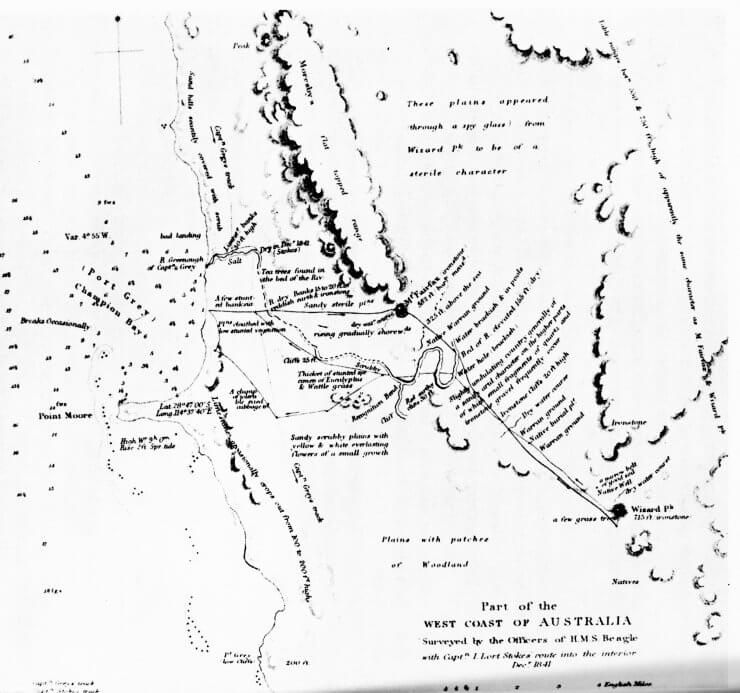
In 1841 M. W. Clifton observed numerous “warrang grounds” inland from Champion Bay/ Geraldton when assessing the area for its potential as an agricultural settlement. He comments favourably on the warrang root as a potential food crop for the new colony:
‘Being desirous of ascertaining the growth of the warrang root, which we observed in every variety of soil in this district, and must, from the number of holes from which it has been dug in all directions in the country, constitute the chief food of the inland tribes, I induced this man to take me to the fire where a party of the same natives were assembled, in order that some of them might go with me to a warrang ground and dig up from the very bottom in my presence a number of roots. Mr Burges advised me to take a double barrelled gun with me, which I unwillingly did; on reaching the fire I found several men and women, the former all of large muscular proportions, and the women stout and more strongly formed than those of the southern districts; they all went with me and dug up a quantity of warrang, which appears to me to be a most valuable root and well deserving garden cultivation, which I intend to attempt.’ (Perth Gazette and Independent Journal of Politics and News, 27th February 1852).
Dr Robert Foley, the first resident surgeon at Champion Bay, is quoted in the Perth Gazette, in a letter to Mr E. Parker, referring to the fertile nature of the Aboriginal yam grounds in the Geraldton hinterland:
‘Writing to me in February last, the doctor [Foley] says, “Last Sunday, myself, Charles Gregory, and the two Beachams went to Mount Fairfax, about six miles from hence, and though the land was once stated to be bad, the B’s [Beachams] said that four or five good farms might be made in that short distance. You can see for miles, and it being dug for warrang, or agace, as they call it here, you can see the nature of the soil everywhere – the good goes three or four feet deep. The flats are covered with kangaroo grass and spears, the old grass not being so dried up as at York’ (Extract from Dr Foley’s letter 1851 published in the Perth Gazette).
Dr Foley is enthusiastic about the expansive, well-dug, deep fertile soils in this region that had been used by the indigenous inhabitants to cultivate one of their staple foods – the Dioscorea yam. Foley recognised the economic potential of these productive yam lands for European agriculture. In 1847 John Septimus Roe during his expedition to Champion Bay and the Hutt River refers to Aboriginal people in the Murchison region “cropping” the roots of the warren. He writes the
‘abundance of the warran plant so highly prized as a food by the natives….’ (Roe 1847 in Hercock 2014: 361)
‘…the numerous holes dug all over this part of the country by the natives, in search of their favourite warran root, which abounds all over this district, but especially near the rivers & stream beds.’ (Roe 1847 in Hercock 2014: 372).
‘….one of the horses fell with his load into one of the very numerous holes dug by the natives in the ground in cropping their warren roots.’ (Roe 1847 in Hercock 2014: 394)
Further south in the vicinity of Gingin and Lennard’s Brook, George Fletcher Moore observed extensive yam grounds when exploring the area in 1835 He describes:
good loamy ground, bearing the “Woyay,” a native yam in abundance.’ (Moore 14th April, 1835 in Schoobert 2005: 425)
Landscapes that were perforated by yam holes were similarly observed in the Chittering/ Bindoon and Toodyay areas. The name Bindoon, according to Glauert (Curator of the WA Museum 1950) means ‘place where the yams grow.’ In 1848 Phillip Chauncy, the Assistant Surveyor, records “warrine” grounds in the Toodyay/ Gidgegannup/Upper Swan area. For example, he records the place name “Warrine-garing” along the banks of Jimperting Brook where:
“The greater part of it is covered with granite rocks – some large and firm & in other places in the form of large to angular loose stones which with the “Warrine” holes made it most difficult to ride over…”(Chauncy field book, 27th October 1848).
Chauncy recorded and mapped “warrine” grounds in the fertile soils of the Upper Swan on the land grants of the European settlers William Shaw, Peter Broun and Lieutenant Irwin. Hallam (1975: 58) includes a copy of Chauncy’s 1843 map and she writes:
‘extensive patches of the yam, Dioscorea hastifolia, being so well defined and fixed that they are marked on the earliest European maps of the area.’ (Hallam 1991:49)
‘Phillip Snell Chauncy’s maps of 1843 show ‘warran holes’ (yam-digging pits) in a ‘dogwood thicket’ over two patches of ground along the northern boundary of the east-west strip granted to Moore’s northern neighbour, William Shaw, extending onto the property of Peter Broun immediately south of the Swan (now Bond’s ‘Brigadoon’ property); and another patch west of the river, on Lieutenant Irwin’s property opposite Moore’s. (Hallam 1991: 49).
Over one hundred and thirty years later Mrs Robin Roe of Beermullah (south of Gingin) describes (what she suggests) were the remains of old yam pits consisting of
‘mounds and holes up to five feet across, and said once to have been three or four feet deep …have been ‘left by natives digging yams or Woorine.’ (Hallam 1975: 13)
‘still discernible as areas of holes and humps’ (Hallam 1975: 72)
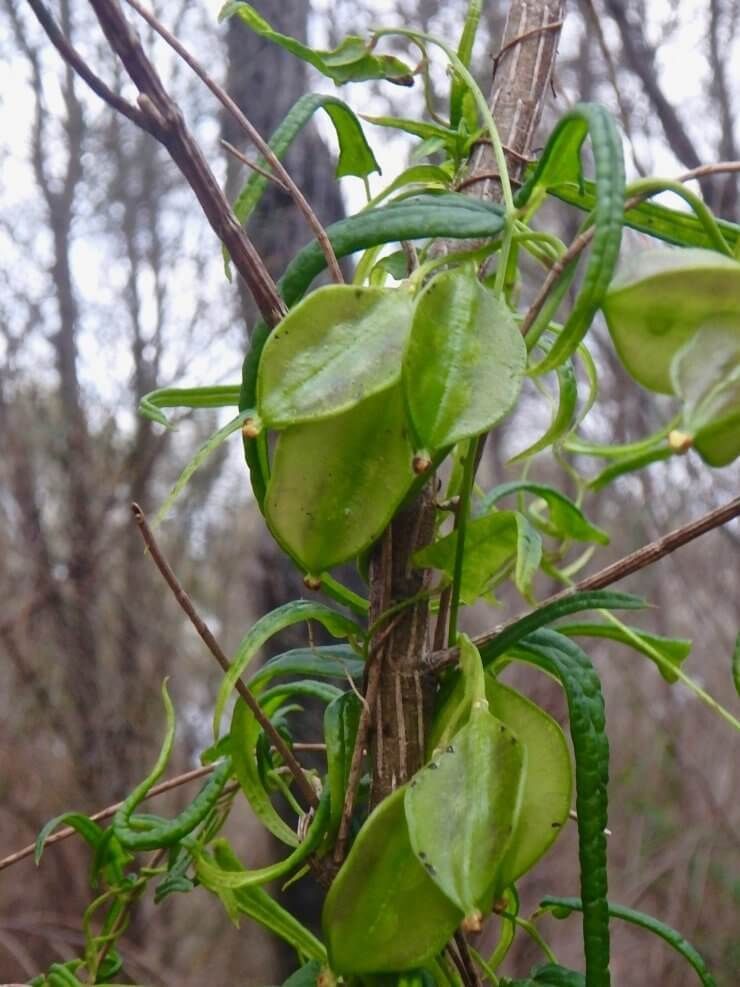
Part 3: The colonial usurpation of traditional yam lands
‘There was something going on in Australia. The explorers noticed it and some wrote about it but as their primary purpose, and that of their sponsors, was to find land for European farming, many of their observations were allowed to slip from view.’ (Pascoe 2014: 125).
It was no secret to the colonists in the Swan River region that the Dioscorea yam formed a principal staple of the indigenous diet. However, as soon as European settlers discovered that the fertile alluvial yam grounds were the best soils in which to grow their European crops and graze their stock, this caused a clash of economic interests between the original landowners who were prevented from accessing and producing their traditional food staples by their new colonial masters. As early as June 6, 1833 Moore describes an awkward situation in which he, as the new landowner at Millendon in the Upper Swan, attempts to discourage a group of Aborigines from accessing and cultivating their traditional yam lands. In his diary he describes how he
“had the “honour” of a visit from ten natives; among them were two well-looking young women, with children at their backs. These were brought here and introduced by “Beelycomera,” Weeip’s son. On their going in the direction of our sheep, I was alarmed (as the shepherds had come for dinner), and wished them to cross the river; but Beelycoomera took a piece of woyay [yam] root and put it in the ground, and began to dig; then pointed where he wished to go. I told him my sheep were there, and expressed my fears; which he removed by assurances that he would do no harm. They passed on. I put a pair of pistols in my pockets, and walking leisurely after them found them busy digging. (Moore 1884: 198)
When Moore says he had the “honour” of a visit he seems to be expressing his surprise that the Aboriginal delegation who wished to attend to their yam crop had come to his house to seek his permission. It was more common for Aboriginal people at that time (1833) to access their land without seeking approval from the new landowner with often devastating consequences, such as flogging, imprisonment or death for larceny (theft) and trespass, despite the fact that only five years previous to this they were the traditional owners of these lands. Moore begrudgingly allows this group onto the land on condition that they do not disturb his sheep but he alerts his reader that if they are troublesome, he has a pair of pistols in his pocket ready to deal with any offending party.
This was the reality of the colonial frontier where indigenous land had been appropriated in the name of the British crown without treaty or compensation. Soon after European settlement when Nyungar people found themselves locked out of their traditional yam lands and hunting grounds, it is not surprising that they had to resort to raiding European gardens and livestock in an attempt to satisfy their hunger requirements. They did not consider this an offence (trespass) as the land had been passed down to them by their ancestors from the beginning of time. This is illustrated in the following incident cited in Hallam and Tilbrook (1990: 46).
1836 November, COKET [COGAT] and the family of MULLEEWAR (MULLEWAR) cleared William Shaw’s potato and turnip crop at “Belvoir”(Upper Swan) and were feared to be waiting to take melons and grapes when ripe. Shaw requested an interpreter because the brothers COGAT and MULLEWAR did not see this as a punishable offence. Previously COKET had been been severely flogged for stealing, but committed a similar offence again within twelve hours (CSR 49/37). Shaw’s root crops were dug up adjacent to an area of “warran holes” on his northern boundary, where Aborigines habitually harvested yams (Chauncy survey 1843, Swan Folio XIX; Hallam 1975:14, 1986, 122, 125). Such yam grounds imply intensive, laborious, repeated harvesting of a valued plant staple, over which a local Aboriginal group would hold usage rights, and which it would husband from year to year by leaving the shoot and part of the yam tuber in place in the soil (Hallam 1986, 1989). The Aborigines were thus harvesting from grounds in which they held usage rights (Tilbrook 1987, 161, 182). (Hallam and Tilbrook 1990: 46)’
‘Land good for Aborigines was land good for Europeans’ (Hallam 1975:72)
The usurpation of the traditional yam lands by European settlers in the Upper Swan saw the rapid destruction of a principal vegetable crop that had formed a cornerstone of the local Aboriginal economy for possibly many thousands of years. Hallam (1991) acknowledges this devastation when she states:
‘Yams, however, were very important to Aboriginal subsistence and settlement patterns because they occurred in concentrated localised patches, mainly on rich alluvial soils. Indeed the European settlers used them as an indicator of good arable land, with devastating consequences for their Aboriginal owners.’ (Hallam 1991:48).
Yam lands located on the fertile alluvium of the Upper Swan were much sought after and fought over by the early colonial settlers who were competing for premium agricultural soils for their European crops and pastures. George Fletcher Moore describes his own luck in acquiring a portion of alluvial land in the Upper Swan where the best lands had already been allocated by November 1830 to colonial elites and absentee landlords in England. He states:
‘The only land available for present purposes is on and near the banks of the rivers; all this is now allotted on both sides of each river [Canning and Swan], almost to their source; but an offer is frequently made of giving one half to a new settler, on condition of his performing the location duties sufficient to secure the whole. I have an offer of this kind on the banks of the Swan River, and think of accepting it; if I do not, I must explore beyond the mountains….’ (Moore 1884: 23, diary entry 12th November 1830).
Within a few years of colonisation, the colonial squirearchy were enthusing over the economic potential of the fertile soils of the Upper Swan. William Shaw of Belvoir in a letter to the Inquirer in 1842 boasts about the highly productive yields of his grape vines that he was using to make high quality wine. He sings the praises of the colonial botanist James Drummond for his advice on the quality of
‘the native hole-land for the culture of the vine. I am satisfied that this kind of soil may be converted into vineyards at an expense of little more than clearing the land, and will produce a grape and wine equal in quality and quantity to any that can be found in the world….and my attention is now being paid to it. ‘ (Shaw’s letter to the Inquirer, 1st June 1842).
Drummond was fully aware that the alluvial lands that Shaw was using for grape cultivation were the annexed yam lands of the traditional inhabitants. This is demonstrated in his response to Shaw’s letter:
‘The discovery that you have made that the vines thrive in the sort of land which produces the native yam, is one I consider of the greatest importance to the colony, as there are many thousand acres of that sort of land now in an excellent state for planting, from the repeated digging of the roots for ages by the natives.’ (Drummond’s letter to the Inquirer, 1st June 1842).
Drummonds’ (1842) over-riding concern here, like most of his contemporaries, was to progress the development of the new colony at all costs whereas the Reverend Wollaston, showing his Christian compassion, openly laments the destructive consequences to the traditional inhabitants who were dispossessed from their ancestral country and yam lands. Frustrated by his discussions with Drummond regarding the opening up of the fertile lands of the Bindoon/ Victoria Plains region to European settlement and agriculture in the 1840’s, Wollaston describes the “Warrang – a root which forms a staple diet for the natives”:
‘In these parts the “warrang” a kind of yam, greatly abounds and grows to a large size. When roasted it is represented as superior to the potato, sweet, pleasant and nourishing. This root flourishes where the best stock feed is found. Hence the [settlers’] usurpation of the ground and the secret destruction of the aborigines.’ (Wollaston cited in Markey 1976:17 and in Hallam 1975: 72).
Part 4: Indigenous science and Yam stick horticulture
‘The Nyungar people of southwestern Australia, like other Aboriginal groups throughout Australia, accumulated over many thousands of years a vast database of empirically based knowledge derived from direct observation and experience of the world around them. This knowledge was handed down through successive generations by oral narrative and song. It included scientific knowledge (ecology, botany, biology, zoology, climatology, astronomy and phenology etc) understood from an indigenous perspective which was often encoded as metaphor in traditional narratives. Indigenous survival would not have been possible without this practical knowledge.’ (Macintyre and Dobson 2017)
Captain Stokes (1846) recognised the economic and environmental benefits that could have been gained from accessing the valuable knowledge possessed by the traditional inhabitants. He was aware that the colonists, who knew very little about the natural resources and environment of the new country, were not taking advantage of this rich source of Aboriginal cultural and scientific knowledge but were instead trying to superimpose their own familiar food production methods onto what was to them an unpredictable and alien environment. The familiar European potato rapidly supplanted the indigenous cultivated native yam without leaving any archaeological or ethnohistorical trace of how this culturally important traditional root vegetable staple was once produced and managed. Stokes states:
‘…nothing could be more unwise than the hostility shown to the natives by the first settlers, as from them we must always calculate on learning much that is useful and valuable, with regard to the productions of the country; a knowledge which would otherwise consume much time to acquire.’ (Stokes 1846 as quoted by Reynolds 1990: 11).
The procedures involved in cultivating the “esculent” yam (as the colonialists called it) remain enigmatic and speculative. We are not aware of any reconstructive ethno-archaeological or agricultural experiments that have been carried out to explain or even speculate as to how this culturally important carbohydrate staple was once cultivated by Nyungar and Yamatji people. Grey (1841) and others provide only superficial descriptions of expansive yam fields and “yam holes” which they observed extending for many miles in all directions often in association well-worn native paths, deep wells and village-like settlements, especially in the Hutt River/Murchison area where it was assumed that the population was quite dense and the settlements were largely permanent. European accounts tend to emphasise the dangers posed to travellers and horses owing to the often thickly studded yam-holes perforating the landscape. We would argue that these holes were not random, opportunistic yam diggings but a traditional form of dry land yam pit horticulture.
Anthropogenic vegetative propagation
“The natives on the West Coast of Australia are in the habit amongst other things of digging up yams as a portion of their means of subsistence; the yams are called ‘ajuca’ in the north and ‘wirang’ in the south. In digging up these yams they invariably re-insert the head of the yams so as to be sure of a future crop…’ (A.C. Gregory interviewed by H. Ling Roth in 1882, published in 1887: 131).
It is well-documented in the ethnobotanical, ethnohistorical and archaeological literature that Aboriginal people in the northern part of southwestern Australia practiced a form of Dioscorea yam cultivation. The surveyor A.C. Gregory, referring to the Nanda people of the Northampton/ Shark Bay area, goes a step further by inferring that the indigenous cultivation of Dioscorea involved “agricultural science” in the yam’s propagation. He comments:
“Agricultural science seemed to have made some progress, as they never dug a yam without planting the crown in the same hole so that no diminution of food supply should result.” (A.C. Gregory originally published in 1885 cited by Gerritsen n.d: 5).
This horticultural theme is also confirmed by the German-born Australian botanist Baron von Mueller who singled out D. hastifolia as the prime example of an indigenous cultivated food that may have potential as a crop for European farmers. He remarks:
‘Dioscorea hastifolia ‘It is evidently one of the hardiest of the yams, and on that account deserves particularly to be drawn into culture. The tubers are largely consumed by aborigines for food; it is the only plant on which they bestow any kind of cultivation, crude as it is.’ (Baron von Mueller cited in Empire 1872:4).
Maiden, the Government Botanist and Director of the Botanic Gardens in Sydney, in his 1889 publication Useful Native Plants of Australia agrees with Baron von Mueller’s stated view. From these 19th century descriptions of indigenous yam cultivation in southwestern Australia, it would seem that vegetative tuber propagation was accomplished by the traditional harvesters by breaking off or cutting the head (or crown) of the tuber and reinserting it back into the friable, aerated soil of the pit.* Grey (1840) records the Nyungar term neer-ran as meaning ‘to plant, to put in the ground’ or niran ‘to plant, to sow’ (Moore 1842: 84). This process of simultaneously re-planting the head of the yam at the time of harvesting the new season tubers suggest an efficient labour and energy-saving method of sustainable horticulture.
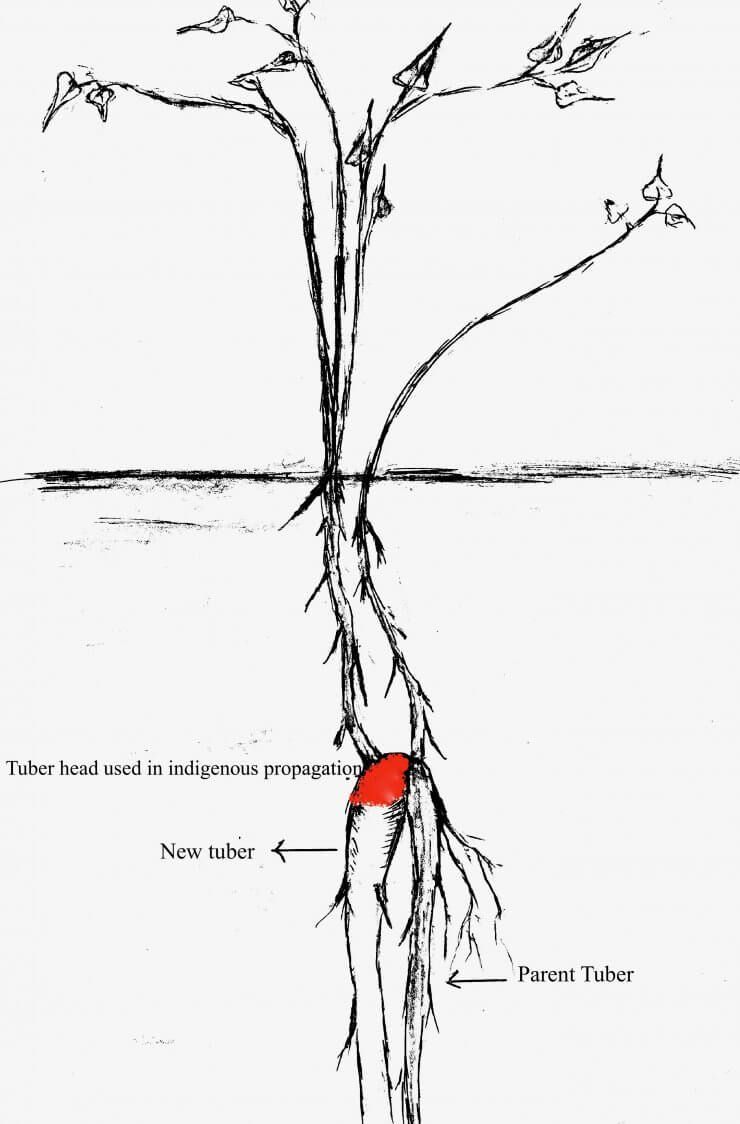
Dioscorea hastifoila is a water hungry perennial that requires moist, rich, loamy, well-drained soil to thrive. Yam grounds were located in semi-arid and Mediterranean climate zones where the rainfall was often variable. The terrain in these regions was often made up of hardened, encrusted, non-porous soils, especially on the lower slopes of hills, where topsoil and surface water were regularly lost through run-off. The construction of pits acted as micro-catchments that enabled water run-off to be directed to the yam root tubers and excess water to infiltrate into the surrounding terrain (see Figure 4).2
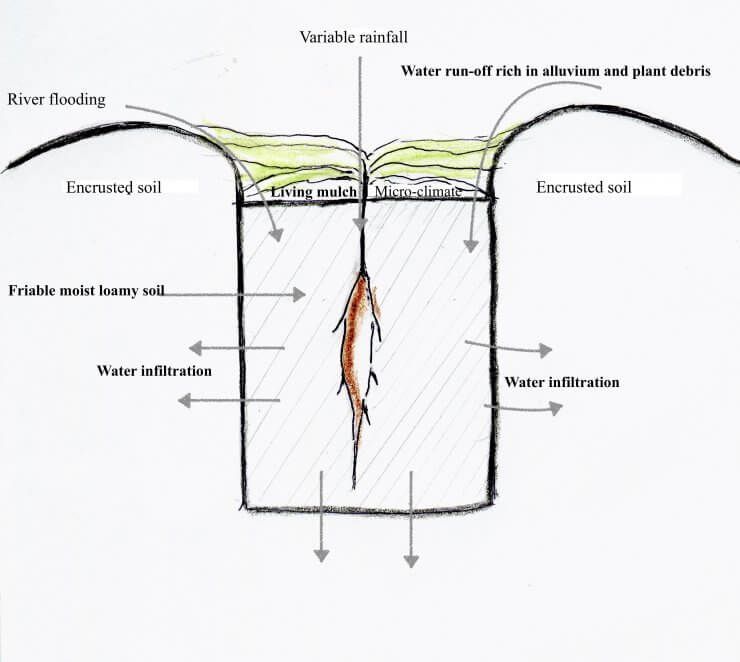
From historical accounts yam pit gardens in northern southwestern Australia were generally located on fertile alluvial soils. Pit construction facilitated the capture of water run-off that was sometimes enriched with alluvium and plant debris, providing a natural self-fertilising, self-mulching and watering process for yam growing. Pit horticulture helped to mitigate against soil erosion, especially on sloping landscapes. This may be seen as an innovative and adaptive method of dry land irrigation or more aptly a form of water harvesting utilising micro-catchments in the form of growing pits to capture variable rainfall.
Historical descriptions illustrate different levels of intensification of yam cultivation in the northern and southern regions where the same species of Dioscorea was cultivated. The climatic conditions in the northern region (e.g. the Irwin District) which differed from those in the south may explain variations in the seasonal harvest regime. The extensive yam fields that were observed in the Murchison region would appear to be more characteristic of a semi-arid, dry land horticultural system than those located in the rich alluvial niches of the Upper Swan, Helena and neighbouring rivers to the north, yet both served a similar function. Historical accounts record variations in the size and circumference of yam holes, possibly explained by differences in soil geography, topography and localised customs.
Ground-covering yam vines – a living mulch
Most cultivated yams of the Dioscorea genus are found in warm tropical climates where climbing vines are usually staked or trellised to provide maximum sunlight for plant growth. From colonial observations of warrain (or atjikoh) cultivation, it would seem that artificial staking was not part of the indigenous horticultural process. Based on our own observations of the ground-covering vines of D. hastifolia in its natural upland habitat at Toodyay, the vine leaves provide a carpet of living mulch that we would suggest helps prevent the loss of soil moisture through evaporation and may also assist in regulating or reducing ground temperature, creating a humid micro-climate conducive to yam growth. We would further speculate that in the cultivated setting this living vine mulch would have been a practical and effective means of conserving ground moisture.
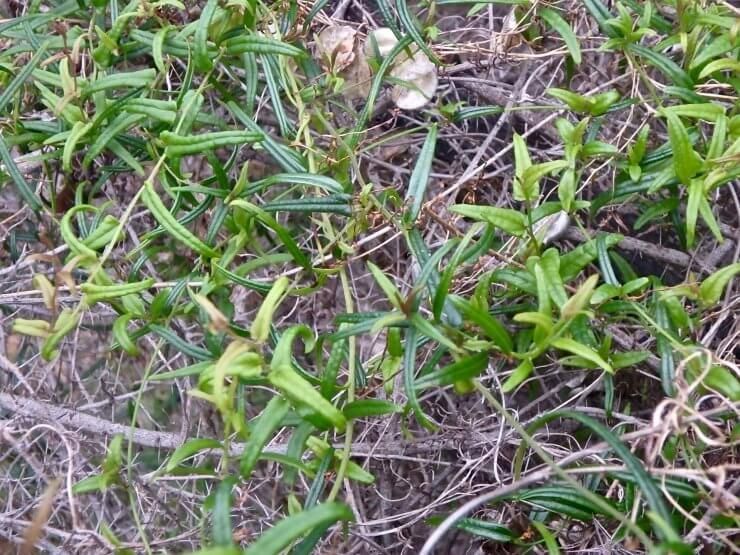
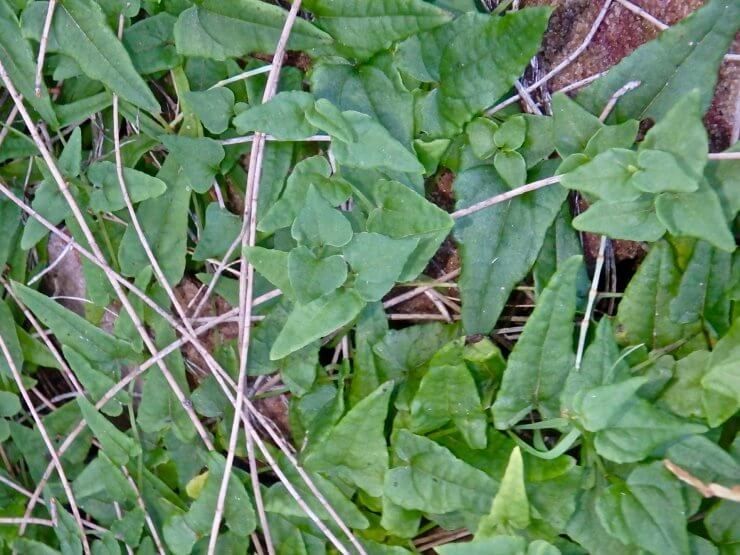
Firing as part of yam-stick horticulture
Anthropogenic controlled burning, sometimes called mosaic or patchwork firing or ‘fire-stick farming’ (Rhys-Jones 1969) was an essential tool in Aboriginal food resource and land management (Hallam 1975, Gott 1982), We are puzzled by Hallam’s (1989:143) vague reference to the protection of yam grounds from firing. This may have been the case in tropical rainforest areas, where yam patches were protected from fire as noted by Jones and Meehan (1989) and Atchison (2000), but we find it hard to believe that the deep rooted D. hastifolia, which goes into dormancy in the hot dry summer season when Aboriginal firing takes place, would have been harmed by anthropogenic patch burning. We maintain that firing would have been an important part of yam cultivation on the alluvial river terraces and lower slopes of hills, in the same way that it was used in the cultivation of yanjet (Typha rhizomes) https://www.anthropologyfromtheshed.com/typha-root-an-ancient-nutritious-food-in-noongar-culture and other food plants, such as bhorn (Haemodorum, bloodroots) djiridji (Macrozamia), djubak (orchids) and karno (Platysace), see our paper on edible Nyungar root vegetables https://anthropologyfromtheshed.com/roots-of-contention-noongar-root-foods-and-indigenous-plant-taxonomy.
Firing helped to maintain and improve soil fertility by providing potassium and other essential nutrients that were favourable to yam growth. Anthropogenic burning prior to the first rains would have ensured the yam harvesters a safe and unobstructed access to their yam gardens by removing the entangled, dense and withered vines that carpeted the pits over summer and autumn providing a sheltered habitat for dangerous snakes. A further advantage of burning the yam plots is that the dense vines and native grasses provided herbage and shelter to a range of other reptiles and marsupials which after the firing process became a valued protein source for human consumption.
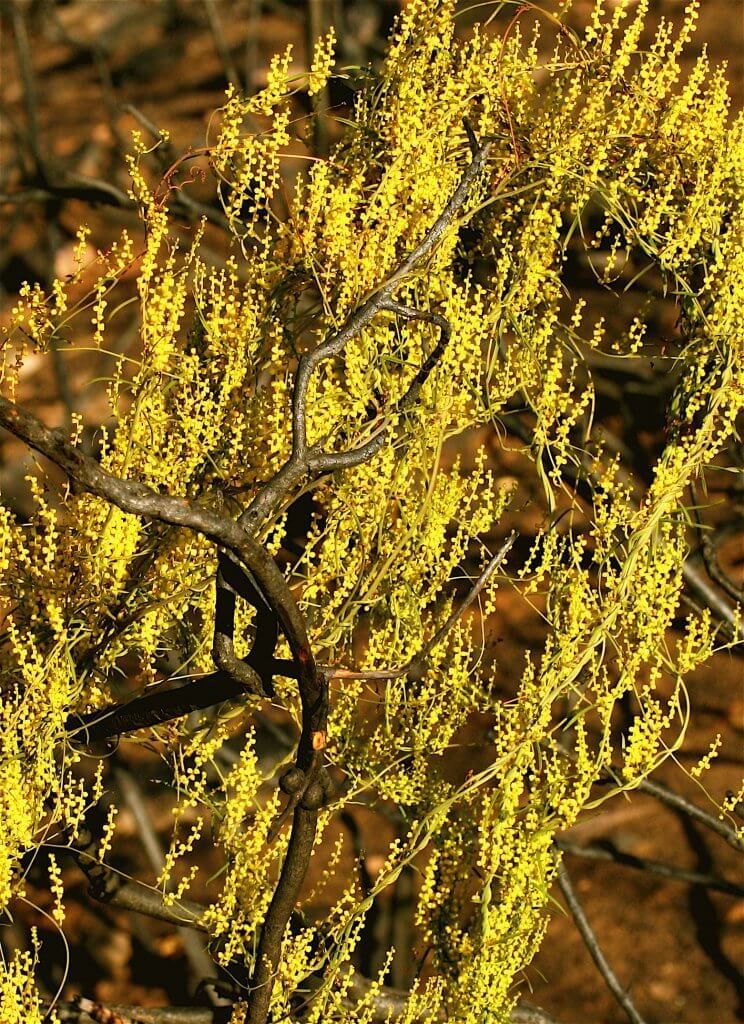
The seasonal timing of yam harvesting
It would appear from the early ethnohistorical records and Hallam’s (1975, 1989, 1998) archaeological analysis that there were two main yam seasons. These were (i) after the first rains of autumn (Grey 1840, 1841; Moore 1842) and (ii) in late spring/ beginning of summer (Gilbert 1848 in Meagher 1974; Oldfield 1865, 2005 and Hammond 1933) when according to Oldfield, referring to the Murchison region, ‘they are in perfection.’ Hammond (1933) describes “warryn” or “adtjikoh” as being consumed at the same time as the “Joo-buk” (orchid tubers) that were consumed in mid-late spring (October-November). See https://anthropologyfromtheshed.com/roots-of-contention-noongar-root-foods-and-indigenous-plant-taxonomy
Grey (1839, 1840, 1841) and Moore (1833, 1842) point out that warran harvesting took place after the first rains of autumn when the soil was easier to dig:
‘at the commencement of the rains, when it is ripe and when the earth is most easily dug; and it forms the principal article of food for the natives at that season…’ (Moore 1842: 75)
Moore refers to a long white parsnip-like root that was dug up in wet weather near his house in the Upper Swan. We can only assume from his description that it was warran. (Hammond 1933 records warryn as “white root”). Moore’s diary describes his encounter with a group of local Aboriginal people on his property at MIllendon in late autumn:
‘One of them had a number of frogs… nicely packed up in the bark of the tea-tree, and tied with grass; these he signified they roasted for food, with a long white root, growing like a parsnip, which they dig up in wet weather.’ (Moore, 4th May 1833).
We would suggest that warrain was also harvested outside these two main seasons but on a smaller-scale “needs” basis. Yam tubers are perfectly built self-storage organs when left in the ground. Aboriginal women were well-acquainted with the phenological cycles of plants and when they were best eaten. They were aware of the subtle changes in taste and nutritional value of different tubers and bulbs at different seasons of the year. These seasonal variations in carbohydrate and sugar levels are noted in our paper on Typha where we explained that the rhizomes were principally harvested in autumn after the first rains when they were easier to dig and when they contained certain sugars, see https://www.anthropologyfromtheshed.com/typha-root-an-ancient-nutritious-food-in-noongar-culture
Atchison and Head (p. 179) confirm that the starch content of Dioscorea spp. also varies seasonally. They note that the starch is replaced by sugars towards the beginning of the growing season:
‘Yam starches are significantly different from other cereal starches in structure and digestibility. The starch content itself changes throughout the dormancy period declining with extended periods of storage and being replaced by sugars such as glucose as the tuber prepares to resprout again (Hariprakesh and Nambison 1996).’
This process of enzymatic conversion of stored carbohydrate to sugars has also been noted by Gott (1983:11) with reference to the tubers of murnong (Microseris sp.) that were a favourite staple of Aboriginal groups in Victoria and South Australia. She states that when the plant is ‘just breaking dormancy in late autumn …[it] has already converted more than a third of its inulin reserve to the soluble sugars fructose and glucose.’
“It is generally considered the province of women to dig roots”
‘It is generally considered the province of women to dig roots, and for this purpose they carry a long pointed stick [wanna] which is held in the right hand and driven firmly into the ground, where it is shaken so as to loosen the earth, which is scooped up and thrown out with the fingers of the left hand, and in this manner they dig with great rapidity. But the labour in proportion to the amount obtained is great. To get a yam about half an inch in circumference and a foot in length they have to dig a hole above a foot square and two feet in depth; a considerable portion of the time of the women and children is therefore passed in this employment.’ (Grey 1841: 292-293).
The wanna or wooden digging stick (also sometimes called “yam-stick” according to Chauncy in Brough-Smith 1878: 255) was an indispensable digging tool used by Aboriginal women. It was a long hardwood crowbar (with a fire hardened point) rounded on one side and flattened on the other. It was individually manufactured, maintained and carried by its female user.

Oldfield (1865, 2005: 55) provides one of the few detailed accounts of how Dioscorea yam was harvested. Although he is referring to the Watchandie (or Nhanda) of the Murchison/ Champion Bay area where the yam was known as ad-ju-co, his description could well apply to the yam-digging activities of Nyungar women.
‘The roots of this plant are very long, for when the women have dug round them to the full reach of their arms, they always break off the part thus freed, leaving the remainder in the ground, and how much further it extends it is impossible to ascertain. However, the part thus secured is generally about three feet in length, varying from a half to two inches in diameter …. The labour of extracting these roots from the ground must be very severe, for they grow in a hard red soil, in which women have to dig with no better implement than a pointed stick. These holes, which render travelling very dangerous in countries where they abound, are from six to eight inches in diameter at the top, the depth being limited to the extent to which a woman can stretch her arms, so as to be able to remove by her hand the soil loosened by the wip-pa (digging-stick). … They are in perfection during the latter part of spring and the fore part of summer…’ (Oldfield 1865, 2005: 55).
Ethnohistorical sources refer to the cooking of the warrain by ‘roasting or baking on hot embers’ (Oldfield 1865, Chauncy 1878, Roth 1902 and personal communication with Nyungar Elder William Warrell in 2000). Oldfield states:
The method of cooking these yams is the same as practised in preparing every other kind of food, animal or vegetable, for eating, i.e., roasting or baking on hot embers, and when thus cooked they are very mucilaginous, of a sweet flavour, and grateful even to the palate of fastidious Europeans (Oldfield 1865).
Chauncy (in Brough-Smith 1878: 245-6) describes the warran yam as having ‘… a delicate sweetish flavour when roasted in hot ashes, something like that of a chestnut, and is much sought after.’ Daisy Bates (1912) documents “dookurn warrain” as ‘cooking or cooked warrain.’ Similarly, Austin (cited in Roth 1902: 6) refers to:
Many kinds of roots and yams were eaten; among the latter, the wor‑rain, showing thick yellow blossoms, was very common, growing down to a depth of quite 3 feet, and running from the thickness of the finger to that of the wrist. An island (? Leschenhault Island) in Shark’s Bay, used literally to be covered with it. All meats, and the majority of the vegetables, were eaten roasted, some of the latter being prepared with great care, the bulrush roots, in particular, a very nourishing dietary, being most methodically slowly cooked in the ashes. (Austin cited in Roth 1902: 6)
A senior Nyungar Elder from the Moora region, the late William Warrell, said that his grandmother Ollie Warrell had told him that women used to dig up warrain yams immediately after the autumn rains but if they were hungry they could dig them up at other times as well. He stated that:
‘It was carefully prepared by cooking in the ashes until it was soft and sweet.’ (William Warrell personal communication 2000).
When we asked if it was eaten raw, he said ‘No, never.’ When we asked him what it tasted like, he could not recall having eaten it.
There have been no scientific studies ever conducted on the nutritional value of cooked D. hastifolia yam. To our knowledge there has only been one study of the nutritive value of the raw D. hastifolia yam. This was conducted by Pate and Dixon (1982:221, Table 5.11) and it showed that the stem tuber (when tested in late spring before summer dormancy) contained 86.0 % water (in fresh weight), 4.9% protein (in dry matter) and 2.0 (medium content) starch value.
Yam harvesting – gender specific or cooperative labour?
Phillip Chauncy in the early 1840’s in the Upper Swan region observed men and women harvesting yams on occasion. He writes:
‘I have seen both men and women sinking in loose sandy soil for an edible root called warran, one of the dioscoreae, which generally grows about the thickness of a man’s thumb, and to the depth of four to six or eight feet… It is dangerous to travel on horseback through the country where it grows, on account of the frequency and depth of the holes, which are not more than about eighteen or twenty inches in diameter. I have sometimes been made aware of their proximity by seeing small quantities of sand jumping up before me, and, on going to see the cause, have suddenly come on a small hole among the scrub, so small that I could scarcely believe a human being could be at the bottom of it in a stooping position, with the knees on each side of the head. In this position the native dextrously throws the sand by a sudden jerk of the hand backwards, under the arm and up behind the shoulder. The only bald natives I ever saw are the warran diggers, who are said to wear the hair off the head by pressing it so frequently against the sides of these holes. (Chauncy in Brough-Smith 1878: 245-6)
There is a widely accepted view, still held by some, that the male/female division of labour was rigidly-defined in Aboriginal society to the point where women were the exclusive collectors/ harvesters of root foods and men were hunters. However, there were times when these roles overlapped and also when men and women joined forces, such as in the harvesting of yams. Although Hallam (1975) perpetuates the idea of Nyungar yam harvesting as being an exclusively female-occupation, this is not necessarily borne out by historical ethnographic evidence, for example, Chauncy’s observations (above) in the Upper Swan area in the early 1840’s where men and women worked cooperatively in the yam harvest. Also, the naturalist John Gilbert reported that he was unable to arrange any male Aboriginal guides from the vicinity of Drummond’s “Hawthornden” estate in Toodyay to accompany him on a collecting expedition to Wongan Hills in October 1848 because they were busily engaged in yam-digging. He writes: ‘their Season of meeting in great numbers to dig the edible Root called by them Wargae is now in full force…’ (Wagstaffe and Rutherford 1954 in Meagher 1974: 33). Wargae here refers to warrain. This term has different renderings, depending on the recorder, for example, the linguist Von Brandenstein (1988: 131) spells it as “wuagarn.” According to Hallam (1998: 14) ‘When they were abundant in fertile soils, yams could provide the basis for large meetings of people for social and ceremonial occasions.’ The cultivated yam (warrain), would have provided a relatively dependable carbohydrate supply to underwrite these important occasions.
The cultural importance of the warrine yam was sometimes reflected in the names of topographic features, such as the tributaries of rivers and creeks, for example, Wariin Brook (a tributary of the Helena River), Waranine Brook (a tributary of the Dale River) and “Warrine-garing” (along Jimperting Brook, Toodyay). The yam was also totemically represented in the names of selected individuals. Hallam and Tilbrook (1990: 300) provide the names of Nyungar people from the Guildford/Upper Swan and York areas whose names identified them to country where yams were found and possibly reflected their status as the proprietors/ custodians of these lands. Their names were Warryneyung (a female), Worraingwert (a male) and Warrain (a male), all deriving from the term for yam – warryne, worraing or warrain.
Human agency in the promotion of yam tuber growth
The question arises as to whether the yam fields and yam grounds described in the early historical and archaeological sources were located in the plant’s natural habitat or had, at some point in prehistory, been translocated from their original environment to a new habitat. Hallam seems convinced that the latter took place when she states:
‘the alluvial flat environments in which these yams were primarily grown by Aborigines were very different from those of their natural habitat of open woodland with granitic and balsatic soils’ (Hallam 1989 in White 2011:88).
If the geographic distribution of the D. hastifolia yam was extended by human agency outside its original range and cultivated, is this not suggestive of indigenous agriculture?
If translocation did take place, this would have resulted in a number of practical advantages such as making it easier to access the yam plots, reducing travel time from camp, reducing the relative amount of time and energy spent digging out the yams. Harvesting yams in their upland stony habitat where they grew in open woodland or vegetation thickets would have been a more onerous task as it necessarily involved tracing the fragile twining stems of the vine down through a rocky substrate to locate the yam that was often buried over two feet down.
From a practical viewpoint the lower slopes and river terrace environment, such as at the Upper Swan region, would have enabled yam cultivators a greater control over essential water capture and soil conservation, and the cultivated friable soil would have contributed to a higher tuber yield per unit of time than in the stony upland areas. Atchison (2012: 69) with reference to the procurement of Dioscorea yam tubers in northern Australia notes that ‘the rockiness of the substrate’ of the ecological niche can critically affect ‘yield per unit time, and thus the calorific efficiency of yam digging.’ This same principle would have applied to the cultivation of D. hastifolia.
The cultivation of yams on the lower slopes and alluvial terraces would have required considerable time and energy input (as noted by Grey 1841) but it would have been more economically productive and rewarding in the rich lowland alluvial soils where soil and water management using micro-pit catchments would have ensured a greater predictability of the tuber crop. We have no information on whether the same yam plots were accessed every season or on a rotational basis allowing time for the soil to regenerate. We may never know whether D. hastifolia was once a domesticated cultivar resulting from its continuous cultivation by Aboriginal people over thousands of years. One can only speculate that this native yam over time would have evolved a larger tuber, augmented productivity and possibly enhanced nutritional content as a result of continuous cultivation. Gott (1982: 10), referring to southeastern Australia, emphasises that human agency (such as tilling, burning and fertilising the soil) in the cultivation of murnong (yam daisy) and other root vegetables promoted an increase in productivity over time and changes to plant phenotypes (Gott 1983 in White 2011:89).
Denham (2007: 2) who has written extensively on yam cultivation in New Guinea and Australia supports the idea of the beneficial effects resulting from cultivation on the yam phenotype but alerts the reader that these changes are contingent on the continuation of cultivation. As Denham writes:
‘The effects of land management, plant exploitation and resultant distributions on plant phenotype can be assessed for Dioscorea hastifolia (Sylvia Hallam) and murnong (Beth Gott). The tubers of these plants, like many others, exhibit phenotypic responses depending upon the type of soil in which they are growing. Where soils are loose and friable, tubers are larger; whereas tubers are smaller in shallow, stony and compacted soils. For most tuberous plants in Australia, the recurrent digging of tubers from a perennial plant will have loosened the surrounding soil and encouraged greater tuber growth. Phenotypic responses can be anticipated in successive harvests of these perennial tubers, but these have nothing to do with planting, intergenerational selection or domestication. These phenotypic responses are elastic, they require the maintenance of anthropically modified soil environment; once modifications to the soil environment cease, tubers revert to wild type.’ (Denham 2007:2).
If this is the case, then the size, structure and possibly even the taste of the tubers of D. hastifolia that was once cultivated by southwest Aboriginal people in pre- and early colonial times may have been very different to those growing in their wild upland habitat today. If the traditional warrain plots were harvested twice a year, as ethnohistorical and archaeological sources suggest (Grey 1840, Moore 1842, Oldfield 1865, Hammond 1933, Hallam 1989), then the seasonally patterned movements of Aboriginal people within their territorial estates may well have accommodated a semi-sedentary existence or what Hallam refers to as largely sedentary settlements in the fertile riverine areas of the Upper Swan where warran (yam) and yanjet (Typha bulrush rhizomes) abounded together with other food resources. Grey (1841) also describes largely permanent settlements based on a yam economy in the Murchison area.
The agricultural debate about whether Australian Aboriginal people were once “farmers” or “foragers,” “hunter-gatherers” or “agriculturalists” continues in academic institutions to this day. In some contexts they are referred to as ‘complex hunter-gatherers,’ ‘affluent hunter-gatherers’ or ‘mobile foragers.’ Notions of sedentism, surplus, domestication, intensification of production, population density and social and political complexity which are criteria often applied by archaeologists to differentiate Aboriginal hunter-gatherers or foragers from agriculturalists have caused endless arguments in the literature. We do not intend to enter this controversial arena here, except to say that some of the notions used to differentiate “agriculturalists” from “foragers” in the Aboriginal context are highly Western-centric and are founded on evolutionary hierarchical models that tend to exclude groups such as those conventionally labelled as “hunter-gatherers” but who practice, what we consider to be, unfamiliar forms of agriculture.
Yam pit horticulture as practised in Western Australia may have been a relatively low maintenance agricultural activity and depending on region possibly supporting a semi-sedentary – or even a largely sedentary as suggested by Grey (1841) and Hallam (1989)) – existence in areas where yams were cultivated and abundant. With the exception of periodic burning and harvesting and replanting, yam pit horticulture was a self-sustaining system (self mulching, self-fertilising and self-watering using rainwater management) and would not have required constant year round presence or surveillance. This flexibility enabled the proprietors of the yam lands and their families to attend to other food resources located within their estate or home range and to prepare for, or participate in, social and ceremonial activities within or outside their own country. They would have had a highly organised and seasonally regularised schedule of economic, social and ceremonial activities based on animal and plant phenological cycles well-known to them within their localised ecosystems.
Yam pit horticulture which utilised the technology of the fire-hardened digging stick (wanna) and a long-evolved specialised knowledge of anthropogenic fire management enabled the original inhabitants of the land to change, adapt and cultivate fertile niches within their local environment. It would seem that Nyungar and Yamatji people discovered through their own innovations the benefits of a form of sustainable dry land pit horticulture, remarkably similar to the agricultural practice known as “Zai” or “Tassa” used by traditional and modern farming communities in the semi-arid regions of northwest Africa, such as in Mali and Burkina Faso.
Part 5: The traditional North African model of pit agriculture
The traditional “Zai” technique is currently undergoing a revival with great success in dry land crop production in parts of Africa. Vegetable staples, such as sorghum, maize and millet, are to this day being successfully cultivated using this method. The technique involves digging pits, using a steel mattock or hoe, each pit measuring about 20-40 cm in diameter and 10-20cm deep and spaced about 60-80 cm apart (Essama 2005:1). The shape, size and depth of the zai pit varies according to region, soil type, rainfall and local cultural traditions. The pits are prepared prior to the wet growing season and mulch consisting of decayed plant matter and animal manure is added to improve soil fertility and prevent moisture loss. After the first rains when the soil is moist, the organic matter is covered with a thin layer of topsoil and the seeds are inserted into the centre of the pit. The Zai method is a proven and highly sustainable dry land agricultural system with many benefits, some of which have been outlined by Essama (2005) as follows:
‘The advantages of Zaï are that it: (i) captures rain and surface/ run-off water; (ii) protects seeds and organic matter against being washed away; (iii) concentrates nutrient and water availability at the beginning of the rainy season; (iv) increases yields; and (v) reactivates biological activities in the soil and eventually leads to an improvement in soil structure. The application of the Zaï technique can reportedly increase production by about 500% if properly executed.’ (Essama 2005)
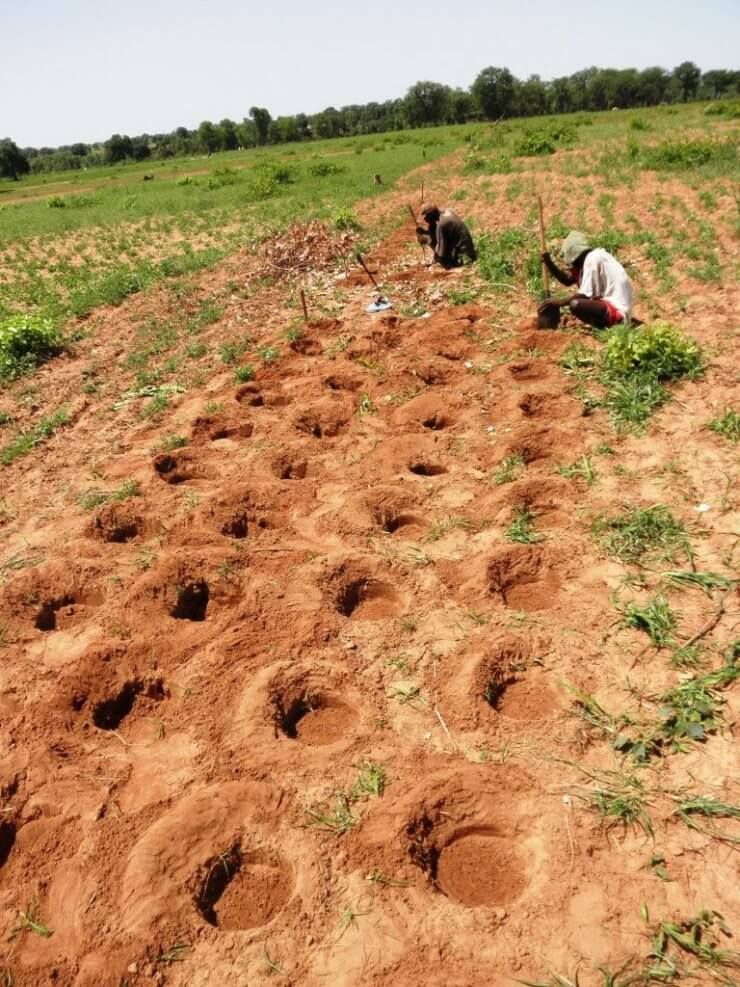
It is our view from the ethnohistorical descriptions of D. hastifolia tuber cultivation that there may have been similarities in the methods of water capture, nutrient enrichment and prevention of soil erosion to that of “zai” pit farming that was practised traditionally (and to this day) in parts of arid and semi-arid northwest Africa. Like the African zai” holes in which seeds (such as sorghum) were planted, the warrain holes in which tubers were harvested and the heads replanted, varied in size, depth and spatial patterning, depending on soil quality, elevation, gradient, repeated usage of the same area over time and local customary practices. By trapping and conserving rainwater, the zai and warrain pit systems were taking advantage of intermittent and unpredictable rainfall. The yam pits served as micro-catchments ensuring that the tubers received maximal water and nutrient enriched run-off during the growing season. We can only conjecture that this type of ecologically sutainable, indigenous tuber horticulture of Western Australia that employed scientific and cultural knowledge accumulated over many thousands of years of empirical observations and trial-and-error would have improved the predictability and productivity of this once important food staple of northern southwest Australia.
Conclusion
Yam pit horticulture was an efficient dry land farming technique where scarce and variable water resources were conserved in basin-like depressions in the ground and directed towards the tuber roots. Excess water that was not utilised by the plant would collect in the surrounding ground, and at deeper levels, thereby conserving ground moisture. This water-harvesting technique may have created micro-climates advantageous to tuber growth. Yam holes, especially on gently sloping ground, would have prevented erosion and increased the soil fertility by trapping plant debris and rich topsoil that otherwise would have been lost as run-off after heavy rainfall. These sunken depressions in the landscape must have functioned as a type of irrigation. Yam pit horticulture would have involved a deep and specialised scientific knowledge of the phenological cycles of the D. hastifolia yam plant and its tuber morphology, taste and nutritional value at different times of the year. There is no doubt in our minds its cultivation involved conscious and deliberate strategies to promote tuber growth (size and thickness) and to regularise and increase crop predictability. It was a self-maintaining horticultural system that, apart from the burning and harvesting activities, did not require all year-round human surveillance but left the yam cultivators free to attend to other seasonal plant and animal resources on their estate. These would have provided a wide range of nutrients and possibly a well-balanced diet.
The question that still remains is: If this indigenous-evolved horticultural practice has been so well documented by the early colonial recorders, then why is it that Nyungar (and Yamatji) people have not been acknowledged in the mainstream literature as traditional “hunter-gatherer-horticulturalists?” It is our view that a ‘hunter-gatherer-horticultural’ model would be a more appropriate designation than the widely accepted and promoted ‘hunter-gatherer’ or ‘forager’ label.
In this paper we have suggested that there may be functional similarities between the dry land pit horticultural methods such as the “zai” technique” used by traditional agriculturalists in northwest Africa and the methods once used in northern southwestern Australia. The anthropogenic techniques of pitting the landscape for the purpose of capturing essential water resources and nutrients to ensure plant growth should be investigated and revived as an effective means of conserving water for agriculture in our variable and drying climate.
All plant specimens photographed in this work have been obtained from our property at Toodyay. It should be noted that it is an offence to collect any native plant or plant product from Crown Land without the appropriate license from the Department of Biodiversity and Conservation.
Our manuscript is still a work in process. We are open to comments and would be grateful to any readers who may have additional information that would contribute to an understanding of how indigenous tuber horticulture was practised in those regions where Dioscorea hastifolia was once cultivated by Nyungar and Yamatji people.
This paper is based on research compiled over many years by research anthropologists Ken Macintyre and Dr Barb Dobson. The information derives from archival ethnohistorical sources as well as information sourced from contemporary Nyungar Elders and spokespersons. We would like to thank all Nyungar people (past and present) who over the years have assisted us by providing cultural information without which this paper would not have been possible. In particular we would like to acknowledge the assistance of Mr Iva Hayward-Jackson, Nyungah Land and Culture Protector and heritage consultant and co-author of this paper for his input and feedback on the ideas presented here.
We would like to alert anyone who is intending to consume Nyungar bush tucker that many indigenous foods are toxic or bitter tasting without the proper processing and preparation. See https://anthropologyfromtheshed.com/beware-bush-food-can-be-dangerous/
ANNOTATIONS
1. Joobaitch (or Jubytch) from the Swan-Guildford area of Perth called the native Dioscorea yam warrain or warrein (as recorded by Bates in the early 1900’s). Hope (1916) also records the term used by Nyungar Elder Tommy Bimbar (1916) as warrain. Nyungar words usually have a number of variant spellings owing to it traditionally being an oral, not written language. Even the name of the people of southwestern Australia Nyungar can be spelt variously as Nyoongar, Noongar, Nyungah or Nyungar depending on individual or group preference. When unfamiliar sounds were rendered into the written word by the early colonial recorders, their different renderings reflected dialectical and regional variations in the Nyungar language and/or the recorder’s own cultural linguistic background and orthographic preference.
2. From our personal observations of the yam (D. hastifolia) growing in upland, stony, loamy soil environments, such as on the hill slope on our property at Toodyay, is that the plant searches out a moist niche, often growing in depressions and crevices between and under rocks during its growing season (around May to September). The yam is deeply buried and very difficult to dig, even with a steel crowbar, owing to the rocky granite terrain which provides a perfect mulch together with bark and other vegetative matter. Yam tubers take advantage of subsurface reservoirs of water that collect at the base of granite outcrops and rocky hollows and the surface rock provides a mulch that traps moisture, providing a favourable environment for yam tuber growth. The plant may be found in a semi-shaded location where it is associated with open woodland and shrubs that provide a natural trellis for its climbing vines.
BIBILOGRAPHY
Above Capricorn 2013 “Sustainable intensification ‘can work for African farmers.’’’ http://abovecapricorn.blogspot.com/2013/04/sustainable-intensification-can-work.html
Armstrong, F., 1836 Manners and habits of the Aborigines of Western Australia. From information collected by Mr F. Armstrong, Interpreter. The Perth Gazette and Western Australian Journal, 29th October 1836, 5th November 1836 and 12th November 1836.
Atchison, J. 2000 Continuity and Change: a late Holocene and post contact history of Aboriginal environmental interaction and vegetation process from the Keep River region, Northern Territory. Ph D. Thesis, University of Wollongong. Research Online https://ro.uow.edu.au/cgi/viewcontent.cgi?article=2967&context=theses
Atchison, J.; Head, L. and R. Fullagar 2005 ‘Archaeobotany of fruit seed processing in a monsoon savanna environment: evidence from the Keep River region, Northern Territory, Australia.’ Journal of Archaeological Science 32: 167–181.
Atchison, J. and L. Head 2012 ‘Yam landscapes: the biogeography and social life of Australian Dioscorea. In The Artefact, Journal of the Archaeological and Anthropological Society of Victoria, Volume 35. Special issue titled ‘The worlds of plants in Aboriginal Australia: essays in honour of Beth Gott. pp 59-74.
Austin, F.R. 1841 (see entry under W.E. Roth 1902)
Backhouse, J., 1843 A Narrative of a Visit to the Australian Colonies. London: Hamilton Adams and Co. Paternoster Co.
Barrett, R. and E.P Tay 2005 Perth Plants: A field guide to the bushland and Coastal Flora of Kings Park and Bold Park. First edition.
Bates, D.M. 1914. A Few Notes on Some South-Western Australian Dialects. Journal of the Royal Anthropological Institute of Great Britain and Ireland 44:65-82.
Bates, D.M. n.d. ‘Jubaitch’ Series 2, Section 10. Typescript ‘native Testaments of old natives’ Adelaide Research & Scholarship, University Library 2015 https://digital.library.adelaide.edu.au/dspace/handle/2440/89394
Bates, D. 1985. The Native Tribes of Western Australia. Isobel White (Ed.) Canberra: National Library of Australia.
Bates, Daisy 1992 Aboriginal Perth: Bibbulmun Biographies and Legends. Peter J. Bridge (ed.) Carlisle, Perth: Hesperian Press.
Bimbar, T. ‘Native Vocabulary. Information supplied to Mr. J. Hope by Native Tommy Bimbar, 15/5/1916.’ Battye Library.
Bindon, P. and R. Chadwick (eds.) 1992 A Nyoongar Wordlist from the South-West of Western Australia. WA Museum, Anthropology Department.
Bindon, P. 1996 Useful Bush Plants. Perth: Western Australian Museum
Bird, C.F.M. and Beeck, C. 1988. Traditional Plant Foods in the Southwest of Western Australia: The Evidence from Salvage Ethnography. In: Meehan, B. and Jones, R. (eds.). Archaeology with Ethnography: An Australian Perspective. Canberra: School of Pacific Studies, Australian National University.
Bliege Bird, R.; Bird, D.W.; Codding, B.F.; Parker, C.H. and J.H. Jones 2008 ‘The “fire stick farming” hypothesis: Australian Aboriginal foraging strategies, biodiversity, and anthropogenic fire mosaics.’ PNAS September 30, 2008 105 (39) 14796-14801; https://doi.org/10.1073/pnas.0804757105
Boers, Th.M. 1994 ‘Rainwater harvesting in arid and semi-arid zones.’ Publication 55. International Institute for Land Reclamation and Improvement, Wageningen, The Netherlands.
Bridge, P. ed. 1992. Aboriginal Perth: Bibbulmun Biographies and Legends by Daisy Bates. Victoria Park, WA: Hesperian Press.
Bridge, P.; Epton, K.; Hercock, M and S. Milentis (eds.) 2009 The finest Goldfields in the World: The Austin Expedition to the Murchison in 1854. Carlisle, WA: Hesperian Press.
Bunbury, W. St. P. and Morrell, W.P. (eds.) 1930 Early days in Western Australia, being the letters and journal of Lieut. H.W. Bunbury, 21st Fusiliers. London: Oxford University Press.
Bunbury, H.W. 1930 ‘Early Days in Western Australia.’ London: Oxford University Press. Journal entries for 1836.
Burges, W. 1851 ‘Champion Bay.’ Inquirer Perth, WA, 17 September 1851, page 2.
Cameron, J. M.R. 2006 The Millendon Memoirs: George Fletcher Moore’s Western Australian Diaries and Letters, 1830-1841. Victoria Park: Hesperian Press.
Cameron, J.M.R. and P. Barnes (eds.) 2014 Lieutenant Bunbury’s Australian Sojourn: the letters and journals of Lieutenant H.W. Bunbury, 21st Royal North British Fusiliers, 1834-1837. Victoria Park, WA: Hesperian Press.
Chauncy, P. 1848 Field book. 27th October. Landgate: Perth, WA.
Chauncy, P. 1878 ‘Notes and anecdotes of the Aborigines of Australia.’ In R.B. Smyth. The Aborigines of Victoria, vol. 2, appendix A: 221-284.
Clark, Dymphna (translator and editor) 1994 Baron Charles von Hugel New Holland Journal, November 1833-October 1834. Melbourne: Melbourne University Press at the Miegunyah Press in association with the State Library of New South Wales.
Clark, W. N. Inquirer 16th February 1842; 1-2.
Clifton, M. 1852 ‘Mr Clifton’s Journal.’ Perth Gazette and Independent Journal of Politics and News, 27th February.
Curr, E.M. 1886-1887 The Australian Race: Its origin, languages, customs, place of landing in Australia, and the routes by which it spread itself over that continent. Vols. 1 & 2. Melbourne: Government Printer.
Danquah, F.O.; Twumasi, M.A.and Asare, I. 2019 ‘Factors influencing zai pit technology adaptation: the case of smallholder farmers in the upper east region of Ghana.’ https://www.researchgate.net/publication/333089639_Factors_Influencing_Zai_Pit_Technology_Adaptation_The_Case_of_Smallholder_Farmers_in_the_Upper_East_Region_of_Ghana
Daw, B., Walley, T. and Keighery, G. (1997) Bush Tucker Plants of the South West. Department of Conservation and Land Management, Western Australia.
Dench, A. 1994 ‘Nyungar’ in Thieberger, N. and W. McGregor Macquarie Aboriginal Words. Sydney: Macquarie University, New South Wales.
Denham, T.P. 2004 ‘The roots of agriculture and aboriculture in New Guinea: looking beyond Austronesian expansion, Neolithic packages and indigenous origins.’ World Archaeology 36: 610–620.
Denham, T. 2007 ‘Traditional forms of plant exploitation in Australia and New Guinea: the search for common ground.’ Veget Hist Archaeobotany DOI 10.1007/s00334-007-0105-y
Drummond, J. 1836 Correspondence to the Editor. Published 18th June in The Perth Gazette and Western Australian Journal, page 710.
Drummond, J. 1837 ‘History of Swan River,’ Swan River Guardian, 11 May 1837, page 115.
Drummond, J. 1839 Letter to Sir William Jackson Hooker, Kew Gardens, London. Written from Hawthornden Farm, Toodjey Valley. July 25.
Drummond, J. 1839 Letter to Sir William Jackson Hooker, Kew Gardens, London. Written from Hawthornden Farm, Toodjey Valley. October 14.
Drummond, J. 1840 ‘Botanical Information.’ Hooker’s Journal of Botany 2.
Drummond, J. 1842, ‘On the botany of Western Australia, Letter to the Editor,’ The Inquirer, a Western Australian Journal of Politics and Literature, 4 May & 1 June.
Drummond, J. 1842 Letter No. 6 to the Inquirer, 10th August.
Drummond, J. 1843 Letter No. 15 to the Inquirer, 22nd March.
Drummond, H. 1862. ‘Useful plants of Western Australia.’ The Technologist 2: 25–28.
Ellwood, W.; Campbell, J.B. and G. Susino 2009 ‘Food-getting, domestication and farming in pre-colonial Australia.’ In J.M. Burdukiewicz; K. Cyrek; P. Dyczek and K. Szymczak (eds.) Understanding the Past: papers offered to Stefan K. Kozlowski Warsaw: University of Warsaw. pp: 115 -122. https://researchonline.jcu.edu.au/27882/1/ellwood_etal_2009.pdf
Empire 1872 A newspaper published in Sydney, New South Wales (1850-1875). Page 4.
Essama, S. (ed.) 2005 ‘The Zai Technique’ IK Notes, No. 80, May 2005- 32184. Reproduced by the Knowledge Sharing Officer, Africa Region, the World Bank. Indigenous Knowledge (IK) Initiatives in sub-Saharan Africa. www.worldbank.org/afr/ik/default.htm
Everist, S.L. 1974 Poisonous Plants of Australia. Sydney: Angus and Robertson.
Florabase, 1994 The Western Australia Flora https://florabase.dpaw.wa.gov.au/
Fraser, Charles 1827 ‘Remarks on the botany etc of the banks of Swan River, Isle of Buache, Baie Geographe, and Cape Naturaliste by Mr Charles Fraser, Colonial Botanist in New South Wales. In J. Shoobert (ed.) Western Australia Exploration. Volume 1. 1826-1835, pp. 46-59. Carlisle, Perth: Hesperian Press.
Gammage, B. 2012 The Biggest Estate on Earth: How Aborigines made Australia. Sydney: Allen & Unwin.
Gerritsen, R. 2002 ‘Nhanda Villages of the Victoria District, Western Australia.’ Canberra: Intellectual Property Publications.
Gerritsen, R. 2008 ‘Australia and the origins of agriculture.’ BAR International Series 1874. Oxford: Archaeopress.
Gerritsen, R. 2010 ‘Evidence for indigenous Australian agriculture.’ Australasian Science 31 (6): 35-37.
Gerritsen n.d. ‘Factors influencing the Adoption of Indigenous Agriculture in Australia.’ pp. 1-19.
Gerritsen, R. n.d. ‘They will offer all friendship: The evidence for cohabitation between indigenous Australians and marooned Dutch mariners and VOC passengers.’ pp. 1-18.
Gilligan, I. ‘Agriculture in Aboriginal Australia: Why not?’ Bulletin of the Indo-Pacific Prehistory Association, 30: 145-156 https://journals.lib.washington.edu/index.php/BIPPA/article/view/9978
Glauert. L. 1950 ‘Provisional list of Aboriginal place-names and their meanings.’ Journal and Proceedings of the Western Australian Historical Society, 4, 2:83-86.
Gott, B. 1982 ‘Ecology of root use by the Aborigines of southern Australia.’ Archaeology in Oceania, 17, pp. 59-67.
Gott B. 1983 ‘Murnong—Microseris scapigera: a study of a staple food of Victorian Aborigines.’ Australian Aboriginal Studies pp. 2–17.
Gott, B. 2012 ‘Indigenous burning and the evolution of ecosystem biodiversity.’ Proceedings of the Royal Society of Victoria, 124(1): 56-60.
Green, N. 1979 Nyungar – The People: Aboriginal customs in the southwest of Australia. Mt Lawley, North Perth: Creative Research Publishers.
Gregory, A.C. and F.T. Gregory, 1884 Journals of Australian Explorations 1846-1858. James Beal, Government Printer: Brisbane. Facsimile edition 1981, Victoria Park: Hesperian Press.
Gregory, A. C. 1887 Memorandum on the Aborigines of Australia. In H. L. Roth 1887 ‘On the Origin of Agriculture.’ Journal of the Anthropological Institute of Great Britain and Ireland 16:131-133. (A.C. Gregory interviewed by H. Ling Roth), Grey, G., 1840 A Vocabulary of the Dialects of South Western Australia. London: T. and W. Boone.
Grey, G., 1841 Journals of Two Expeditions of Discovery in North-West Australia. London: T. and W. Boone.
Hallam. S.J. 1975 Fire and Hearth a Study of Aboriginal Usage and European Usurpation in South Western Australia. Canberra: Australian Institute of Aboriginal Studies. First edition.
Hallam, S. J. 1989 ‘Plant usage and management in southwest Australian Aboriginal societies.’ In D. Harris & G. Hillman (eds.) Foraging and farming: the evolution of plant exploitation pp. 136–151. London, United Kingdom: Unwin publishers.
Hallam, S. J. 1991 ‘Aboriginal Women as Providers: the 1830s on the Swan’ Aboriginal History, Vol. 15. Part 1. pp. 38-53.
Hallam, S.J. 1998 Aborigines of the York Area. York, WA: The York Society (Inc.)
Hallam, S.J. 2002 ‘Peopled landscapes in southwestern Australia in the early 1800’s: Aboriginal burning off in the light of Western Australia historical documents.’ Early Days: Journal of the Royal Western Australian Historical Society, 12, 2: 177-191.
Hallam, S.J. and L. Tilbrook (eds.) 1990 Aborigines of the southwest region 1829-1840. Vol. 8. Nedlands: University of WA Press.
Hammond, J.E., 1933 Winjan’s People. Perth: Imperial Printing Co.
Hansen, V. and J. Horsfall 2019 Bushfood plants and fungi of the south-west of Western Australia. Crawley: UWA Publishing.
Hedrick, U.P. (ed.) 1919 Sturtevant’s Edible Plants of the World with updated botanical names by Michael Moore. http://www.swsbm.com/Ephemera/Sturtevants_Edible_Plants.pdf
Hercock, M.; Milentis, S. with P. Bianchi (eds.) 2011 Western Australian Exploration 1836-1845: The Letters, Reports and Journals of Exploration and Discovery in Western Australia. Carlisle, WA: Hesperian Press.
Hope, J. 1916 Native vocabulary. Information hereunder supplied to Mr J. Hope by Native Tommy Bimbar, 15/5/1916. Battye Library. Western Australia.
Jones, R. 1969 ‘Fire stick farming.’ Australian Natural History, 16, 7: 224-228.
Jones, R. and B. Meehan, 1989 ‘Plant foods of the Gidjingali: ethnographic and archaeological perspectives from northern Australia on tuber and seed exploitation. In D.R. Harris and G.C. Hillman (eds.) Foraging and Farming: the evolution of plant exploitation. London: Unwin Hyman.
Lehmann, C. and L. Preiss 1844-1848, Plantae Preissianae Vol 2 https://www.biodiversitylibrary.org/item/9228#page/37/mode/1up
Lullfitz, A.; Dortch, J.; Hopper, S.; Pettersen, C.; Reynolds, R. and D. Guilfoyle 2017 ‘Human Niche Construction: Noongar Evidence in Pre-colonial Southwestern Australia. ’Conservation & Society, 15 (2): 2-1-216. Ashoka Trust for Research in Ecology and the Environment and WoltersKluwer India Pty. Ltd. https://api.research-repository.uwa.edu.au/portalfiles/portal/20940028/Lullfitz_et_al_2017_Human_Niche_Construction.pdf
Lyon, R.M. 1833 ‘A Glance at the Manners, and Language of the Aboriginal Inhabitants of Western Australia; with a short vocabulary.’ 23rd March in N. Green (ed.) 1979 Nyungar -The People: Aboriginal customs in the southwest of Australia. Perth: Creative Research.
Macintyre, K. and B. Dobson 2017 anthropologyfromtheshed.com
Maiden, J.H. 1889 The Useful Native Plants of Australia. Sydney: Turner and Henderson.
Markey, D. 1976 Historical geography of early nineteenth century Western Australia. Mount Lawley, Australia: Mount Lawley College of Advanced Education. Edith Cowan University publications. Available at Research Online http://ro.ecu.edu.au/ecuworks/6997
Meagher, S.J., 1974 The food resources of the Aborigines of the south-west of Western Australia. Records of the West Australian Museum 3(1): 14–65.
Moore, G.F. 1835 ‘Excursion to the Northward’ from the journal of George Fletcher Moore. Esq.’ Perth Gazette and Western Australian Journal, 26 April and 2 May; also reprinted in J. Shoobert (ed.) 2005 Western Australian Exploration Volume 1: 1826-1835. Victoria Park: Hesperian Press pp. 421-427.
Moore, G.F., 1842 A Descriptive Vocabulary of the Language in Common Use Amongst the Aborigines of Western Australia. London: W.S. Orr and Co.
Moore, G. F. 1884 Descriptive vocabulary in two parts. In Diary of Tens Years Eventful Life of an Early Settler in Western Australia, pp1-119. London: Walbrook.
Mulvaney, J. and N. Green 1992 Commandant of Solitude: The Journals of Captain Collet Barker 1828-1831, Carlton, Victoria: Melbourne University Press.
Oldfield, A. 1865 On the Aborigines of Australia. Transactions of the Ethnological Society of London 3: 215-298. Republished 2005 Hesperian Press, Perth.
Oweis, T. and A. Hachum 2004 ‘Water Harvesting and Supplemental Irrigation for Improved Water Productivity of Dry Farming Systems in West Asia and North Africa.’ “New directions for a diverse planet.” Proceedings of the 4th International Crop Science Congress, 26 Sep – 1 Oct 2004, Brisbane, Australia. Published on CDROM. Web site www.cropscience.org http://citeseerx.ist.psu.edu/viewdoc/download?doi=10.1.1.562.2366&rep=rep1&type=pdf
Parker, E. 1851 ‘To the Editor of the “Independent Journal.”’ York, Jan 20.
Parker, E. 1851 ‘Conclusion of extracts from Dr. Foley’s letters, Oct 1850.’ Perth Gazette and Independent Journal of Politics and News, 21st February.
Pascoe, Bruce 2014 Dark Emu: Black seeds agriculture or accident? Broome: Magabala Books.
Pate, J.S. and K.W. Dixon. 1982. Tuberous, cormous and bulbous plants: biology of an adaptive strategy in Western Australia. Perth: University of Western Australia Press.
Paterson, C.A. 1896 ‘Notes about the tribes inhabiting the coastal district from Geraldton to Albany, and those of territories nearest adjoining them.’ Transactions of the Royal Society of South Australia, 16: 288-291.
Reynolds, R. 1990 With the White People: The crucial role of Aborigines in the exploration and development of Australia. Ringwood, Victoria: Penguin Books.
Roe, J.S, 1847 ‘Expedition to Champion Bay and Hutt River estuary, June 1847, Fieldbook.’ In M. Hercock and the Western Australian Explorers’ Diaries Project 2014 pp. 355 – 408.
Roe, J. S. 1847 Report on Champion Bay and its vicinity by J. S. Roe, Surveyor- General, July 12, 1847. In Exploration Diaries, Vol 4. pp.20-33. Battye Library: PR 5441.
Roth, W.E. 1902 ‘Notes of savage life in the early days of West Australian settlement.’ In Royal Society of Queensland. Proceedings, vol. 17:45-69. Based on reminiscences collected from F. Robert Austin, Civil Engineer, late Assistant Surveyor, W.A. (1841). Paper read before the Royal Society of Queensland 8th March 1902.
Rowley-Conwy, P. and R. Layton 2011 ‘Foraging and Farming as niche construction: stable and unstable adaptations.’ Phil. Trans. R. Soc. B. 366, 849-862.
Salvado R., 1851 in E.J. Stormon 1977 The Salvado memoirs: Historical memoirs of Australia and particularly of the Benedictine Mission of New Norcia and of the habits and customs of the Australian natives. By Rosendo Salvado, translated and edited by E.J. Stormon. Nedlands: University of Western Australia Press.
Sharr, F.A. 1996 Western Australian plant names and their meanings: a glossary. Nedlands: University of Western Australia Press.
Shaw, W. 1842 ‘Correspondence: Cultivation of the Vine.’ Inquirer, 1st June, page 4
Shoobert (ed.) 2005 Western Australian Exploration 1826-1835, The Letters, Reports & Journals of Exploration and Discovery in Western Australia. Vol 1. Victoria Park: Hesperian Press.
Smyth, R.B. 1878. The Aborigines of Victoria. Melbourne: Victorian Government Printer.
Stokes, J.L. 1841 ‘Visit to the country adjacent to Champion Harbour, reported to be Port Grey, and examination of the coastline to the northward.’ Perth Gazette 25 December, pp.2-3.
Stokes, J.L., 1846. Discoveries in Australia; With an Account of the Coasts and Rivers Explored and Surveyed During the Voyage of the H.M.S. Beagle in the years 1837–43. London: T. and W. Boone.
Stormon E. J. 1977 The Salvado Memoirs. Nedlands: University of Western Australia Press.
Symmons, C. 1841 Grammatical introduction to the study of the Aboriginal language of Western Australia. Perth: Western Australia Almanac.
Thieberger, N. and McGregor,W. Macquarie Aboriginal Words. Macquarie University, New South Wales.
Tindale, N.B. 1974 Aboriginal Tribes of Australia. Berkeley: University of California Press.
Von Brandenstein, C. G. 1988 Nyungar Anew. Pacific Linguistics, Series C – No. 99. Department of Linguistics, Research School of Pacific Studies, Australian National University.
Von Hugel, Baron Charles 1833 in Clark, D. (translator and editor) 1994 New Holland Journal November 1833-October 1834. Melbourne: Melbourne University Press at the Miegunyah Press in Association with the State Library of New South Wales.
Warrell, W. 2000 Nyungar Elder, personal communication.
Western Australia Florabase https://florabase.dpaw.wa.gov.au/
Wheatbelt Natural Resource Management 2009 ‘Nyungar Budjara Wangany Nyungar NRM Wordlist & Language Collection Booklet of the Avon Catchment Region.’ Northam, WA. https://www.wheatbeltnrm.org.au/sites/default/files/knowledge_hub/documents/nyungar-dictionary.pdf
White, I. (Ed.) 1985 The Native Tribes of Western Australia. Canberra: National Library of Australia
White, P. 2011 ‘Revisiting the ‘Neolithic problem’ in Australia.’ Records of the Western Australian Museum, 79. Supplement
Zougmore, R.; Jalloh, A. and A.Tioro 2014 ‘Climate-smart soil water and nutrient management options in semiarid West Africa: a review of evidence and analysis of stone bunds and zai techniques,’ Agriculture & Food Security, 3: 16.
